Writing a Research Paper Introduction (with 3 Examples)
Nail your research paper's introduction! Learn to captivate and inform readers from the start—our guide shows how!

Ertugrul Portakal
Apr 12, 2024
%20(3).png)

TABLE OF CONTENTS
A catchy and informative introduction is essential in academic writing, especially if you want your readers to have background information about your paper. However, writing an interesting and informative introduction can sometimes be a time-consuming and tiring process. If you don't know where to start when crafting an introduction, no need to worry - we've got you covered!
In this article, we will explain step by step what an introduction is in academic writing and how to write it!
Ready? Let's start!
- An introduction is a paragraph that provides information about your entire paper and aims to attract and inform the reader.
- Before writing an introduction or even starting your paper, you need to research academic sources.
- The first one or two sentences of an introduction paragraph should be a hook to attract the reader's attention.
- Afterwards, you need to prepare the reader for your argument by giving background information about your topic.
- Finally, you should state your argument about your topic with a thesis statement.
- If you are writing a longer paper, you can inform your readers about the map of your paper.
- If you are looking for an AI assistant to support you throughout your writing process, TextCortex is designed for you with its advanced features.
What is an Introduction in a research paper?
In any academic writing, including essays and research papers, an introduction is the first paragraph that the reader will encounter. This paragraph should both attract the reader's attention and give them the necessary information about the paper. In any academic paper, the introduction paragraph constitutes 10% of the paper's total word count. For example, if you are preparing a 3,000-word paper, your introduction paragraph should consist of approximately 300 words. You should also write sentences within these 300 words that will attract the reader's attention and provide them with information about the paper.
Importance of an Introduction Paragraph
The biggest function of an introduction paragraph is to prepare the reader for the author's thesis statement. A traditional introduction paragraph begins with a few sentences or questions that will catch the reader's attention. After attracting the reader's attention, necessary background information on the subject is given. Finally, the author explains to the readers what the whole paper is about by stating the thesis. A thesis statement is the final sentence that summarizes the main points of your paper and conveys your claim.
First Things First: Preliminary Research
When working on any academic writing type, it is essential to start by researching your topic thoroughly before beginning to type. What sets academic writing apart from other writing types is the requirement for it to be written using accurate information from reliable sources.
Researching academic sources can be a time-consuming and unnecessary process. One has to read through hundreds of pages, review dozens of articles and verify the accuracy of each source. However, if you're looking to reduce your workload and maximize efficiency by automating repetitive tasks such as literature review, ZenoChat is the perfect solution for you. With its web search feature, ZenoChat can use the entire internet as a data source. Additionally, by activating the "scholar" option of the ZenoChat web search feature, you can ensure that it only uses academic sources when generating output.
How to Create an Introduction for Academic Writing?
Creating an introduction paragraph that is interesting, informative, and conveys your thesis is an easier process than it seems. As long as you have sufficient information about your topic and an outline , you can write engaging introductions by following a few simple steps. Let's take a closer look at how to write an introduction for academic writing.
1-) Start with a Catchy Hook
Your first sentence is one of the factors that most influence a reader's decision to read your paper. This sentence determines the tone of your paper and attracts the reader's attention. For this reason, we recommend that you start your introduction paragraph with a strong and catchy hook sentence.
- Avoid long and complex sentences
- Use clear and concise sentences
- Write a sentence that will spark the reader's curiosity
- You can ask questions that will encourage the reader to read the remaining paragraph
- Avoid fact or overly broad sentences
- Avoid using dictionary definitions as your hook
2-) Give Background Information
After writing a strong hook sentence, you need to provide basic information about your topic so that the reader can understand what they will learn about when they read your paper. In this section, you can benefit from opinions that support or oppose your argument. Additionally, this section should refer to the body paragraphs of your writing.
- You can write a background information sentence for each body paragraph.
- The information here should be concise and compact
- Avoid talking about your evidence and results unless necessary.
3-) State Your Thesis
After attracting the reader's attention and providing background information, it is time to present your approach and argument towards the topic with a thesis statement. A thesis statement usually comprises one or two sentences and communicates the paper's argument to the reader. A well-written thesis statement should express your stance on the topic.
- Avoid merely stating a fact
- Claim your argument
4-) Tell Reader About Your Paper
Although you need to move on to body paragraphs after the thesis statement in short papers, it will be useful to add a few sentences that will guide the reader in your longer papers. This way, your readers can better understand which arguments they will encounter on which pages and the course of your paper. That leads the reader to clearly understand and follow your content.
Let’s Wrap it Up
Writing an interesting and informative introduction is usually a long process that requires a lot of rewriting. You may need to rewrite a sentence dozens of times so that your words and sentences clearly describe your paper and argument. Fortunately, you can generate state-of-the-art introductions using AI tools and use them with a little editing.
When it comes to text generation, paraphrasing, and grammar & spelling checking, TextCortex is the way to go with its advanced LLMs and customization options. With TextCortex, you can generate all writing types, including introduction, from scratch, rewrite your existing texts, change their tone of voice, or fix their grammar. TextCortex is available as a web application and browser extension. The TextCortex browser extension is integrated with 30,000+ websites and apps. So, you can complete your AI-driven writing tasks anywhere and anytime.
Let's examine a few sample introductions generated by TextCortex.
Example Introduction #1
“Should social media platforms be banned from collecting their users' data?”

Example Introduction #2
“Do electric vehicles decrease overall emissions?”

Example Introduction #3
“Is graffiti an act of vandalism or the creation of art?”

One AI copilot that truly gets you.
Connect multiple data sources, define the voice for your AI and taste what it feels like to have a fully-personalized AI copilot on 50,000+ platforms.
Did you like this article? Explore a few more related posts.
%20(6).png)
How to Create a Strong Thesis?
%20(5).png)
Top 3 AI Tools That Write Essays (Free & Paid)
%20(4).png)
5 Main Essay Types & Guide with Examples
Questions answers..
TextCortex is a powerful AI-powered writing tool that can help you reduce your writing time, handle big tasks, and create high-quality content without errors. With its customizable platform, personalized intelligence experience, advanced writing and research capabilities, and error-free content, TextCortex is the perfect tool for creative professionals who want to be a creative force in their industry.
Our AI copilot learned how to write from more than 3 billion sentences and has the ability to create unique content. However, fact-checking is something which still requires a human approval.
TextCortex supports more than 25 languages including English, Dutch, German, Ukranian, Romanian, Spanish, Portuguese, French, Italian.
Yes, TextCortex is completely free to use with all of its features. When you sign up, you receive 100 free creations. Then you will receive 20 recurring creations every day on the free plan.
Yes, we have a Text Generation API, please talk to us directly to implement it. You can reach out to us at [email protected]
Account sharing is not allowed. If you have a need for more than 5 seats for an account, you can directly contact us at [email protected]
Yes, TextCortex offers 14-day free trial for users to try out all features extensively with higher number of generations. But keep in mind that you can already try everything with the free plan. There is no feature that is locked behind a premium plan.
Overall, TextCortex AI has over 1000 five-star reviews on reputable review sites such as G2, Trustpilot and Capterra.
TextCortex learns and adapts to your unique writing style and knowledge, making it easier for you to write high-quality & personalized content.
Your premium features will be available until the end of your subscription date, then your account plan will be set to Free plan.
General Questions
Your ai copilot is ready to collaborate with you..
Connect your knowledge, customize the style and start collaborating with your AI copilot.
- Privacy Policy

Home » Research Paper – Structure, Examples and Writing Guide
Research Paper – Structure, Examples and Writing Guide
Table of Contents

Research Paper
Definition:
Research Paper is a written document that presents the author’s original research, analysis, and interpretation of a specific topic or issue.
It is typically based on Empirical Evidence, and may involve qualitative or quantitative research methods, or a combination of both. The purpose of a research paper is to contribute new knowledge or insights to a particular field of study, and to demonstrate the author’s understanding of the existing literature and theories related to the topic.
Structure of Research Paper
The structure of a research paper typically follows a standard format, consisting of several sections that convey specific information about the research study. The following is a detailed explanation of the structure of a research paper:
The title page contains the title of the paper, the name(s) of the author(s), and the affiliation(s) of the author(s). It also includes the date of submission and possibly, the name of the journal or conference where the paper is to be published.
The abstract is a brief summary of the research paper, typically ranging from 100 to 250 words. It should include the research question, the methods used, the key findings, and the implications of the results. The abstract should be written in a concise and clear manner to allow readers to quickly grasp the essence of the research.
Introduction
The introduction section of a research paper provides background information about the research problem, the research question, and the research objectives. It also outlines the significance of the research, the research gap that it aims to fill, and the approach taken to address the research question. Finally, the introduction section ends with a clear statement of the research hypothesis or research question.
Literature Review
The literature review section of a research paper provides an overview of the existing literature on the topic of study. It includes a critical analysis and synthesis of the literature, highlighting the key concepts, themes, and debates. The literature review should also demonstrate the research gap and how the current study seeks to address it.
The methods section of a research paper describes the research design, the sample selection, the data collection and analysis procedures, and the statistical methods used to analyze the data. This section should provide sufficient detail for other researchers to replicate the study.
The results section presents the findings of the research, using tables, graphs, and figures to illustrate the data. The findings should be presented in a clear and concise manner, with reference to the research question and hypothesis.
The discussion section of a research paper interprets the findings and discusses their implications for the research question, the literature review, and the field of study. It should also address the limitations of the study and suggest future research directions.
The conclusion section summarizes the main findings of the study, restates the research question and hypothesis, and provides a final reflection on the significance of the research.
The references section provides a list of all the sources cited in the paper, following a specific citation style such as APA, MLA or Chicago.
How to Write Research Paper
You can write Research Paper by the following guide:
- Choose a Topic: The first step is to select a topic that interests you and is relevant to your field of study. Brainstorm ideas and narrow down to a research question that is specific and researchable.
- Conduct a Literature Review: The literature review helps you identify the gap in the existing research and provides a basis for your research question. It also helps you to develop a theoretical framework and research hypothesis.
- Develop a Thesis Statement : The thesis statement is the main argument of your research paper. It should be clear, concise and specific to your research question.
- Plan your Research: Develop a research plan that outlines the methods, data sources, and data analysis procedures. This will help you to collect and analyze data effectively.
- Collect and Analyze Data: Collect data using various methods such as surveys, interviews, observations, or experiments. Analyze data using statistical tools or other qualitative methods.
- Organize your Paper : Organize your paper into sections such as Introduction, Literature Review, Methods, Results, Discussion, and Conclusion. Ensure that each section is coherent and follows a logical flow.
- Write your Paper : Start by writing the introduction, followed by the literature review, methods, results, discussion, and conclusion. Ensure that your writing is clear, concise, and follows the required formatting and citation styles.
- Edit and Proofread your Paper: Review your paper for grammar and spelling errors, and ensure that it is well-structured and easy to read. Ask someone else to review your paper to get feedback and suggestions for improvement.
- Cite your Sources: Ensure that you properly cite all sources used in your research paper. This is essential for giving credit to the original authors and avoiding plagiarism.
Research Paper Example
Note : The below example research paper is for illustrative purposes only and is not an actual research paper. Actual research papers may have different structures, contents, and formats depending on the field of study, research question, data collection and analysis methods, and other factors. Students should always consult with their professors or supervisors for specific guidelines and expectations for their research papers.
Research Paper Example sample for Students:
Title: The Impact of Social Media on Mental Health among Young Adults
Abstract: This study aims to investigate the impact of social media use on the mental health of young adults. A literature review was conducted to examine the existing research on the topic. A survey was then administered to 200 university students to collect data on their social media use, mental health status, and perceived impact of social media on their mental health. The results showed that social media use is positively associated with depression, anxiety, and stress. The study also found that social comparison, cyberbullying, and FOMO (Fear of Missing Out) are significant predictors of mental health problems among young adults.
Introduction: Social media has become an integral part of modern life, particularly among young adults. While social media has many benefits, including increased communication and social connectivity, it has also been associated with negative outcomes, such as addiction, cyberbullying, and mental health problems. This study aims to investigate the impact of social media use on the mental health of young adults.
Literature Review: The literature review highlights the existing research on the impact of social media use on mental health. The review shows that social media use is associated with depression, anxiety, stress, and other mental health problems. The review also identifies the factors that contribute to the negative impact of social media, including social comparison, cyberbullying, and FOMO.
Methods : A survey was administered to 200 university students to collect data on their social media use, mental health status, and perceived impact of social media on their mental health. The survey included questions on social media use, mental health status (measured using the DASS-21), and perceived impact of social media on their mental health. Data were analyzed using descriptive statistics and regression analysis.
Results : The results showed that social media use is positively associated with depression, anxiety, and stress. The study also found that social comparison, cyberbullying, and FOMO are significant predictors of mental health problems among young adults.
Discussion : The study’s findings suggest that social media use has a negative impact on the mental health of young adults. The study highlights the need for interventions that address the factors contributing to the negative impact of social media, such as social comparison, cyberbullying, and FOMO.
Conclusion : In conclusion, social media use has a significant impact on the mental health of young adults. The study’s findings underscore the need for interventions that promote healthy social media use and address the negative outcomes associated with social media use. Future research can explore the effectiveness of interventions aimed at reducing the negative impact of social media on mental health. Additionally, longitudinal studies can investigate the long-term effects of social media use on mental health.
Limitations : The study has some limitations, including the use of self-report measures and a cross-sectional design. The use of self-report measures may result in biased responses, and a cross-sectional design limits the ability to establish causality.
Implications: The study’s findings have implications for mental health professionals, educators, and policymakers. Mental health professionals can use the findings to develop interventions that address the negative impact of social media use on mental health. Educators can incorporate social media literacy into their curriculum to promote healthy social media use among young adults. Policymakers can use the findings to develop policies that protect young adults from the negative outcomes associated with social media use.
References :
- Twenge, J. M., & Campbell, W. K. (2019). Associations between screen time and lower psychological well-being among children and adolescents: Evidence from a population-based study. Preventive medicine reports, 15, 100918.
- Primack, B. A., Shensa, A., Escobar-Viera, C. G., Barrett, E. L., Sidani, J. E., Colditz, J. B., … & James, A. E. (2017). Use of multiple social media platforms and symptoms of depression and anxiety: A nationally-representative study among US young adults. Computers in Human Behavior, 69, 1-9.
- Van der Meer, T. G., & Verhoeven, J. W. (2017). Social media and its impact on academic performance of students. Journal of Information Technology Education: Research, 16, 383-398.
Appendix : The survey used in this study is provided below.
Social Media and Mental Health Survey
- How often do you use social media per day?
- Less than 30 minutes
- 30 minutes to 1 hour
- 1 to 2 hours
- 2 to 4 hours
- More than 4 hours
- Which social media platforms do you use?
- Others (Please specify)
- How often do you experience the following on social media?
- Social comparison (comparing yourself to others)
- Cyberbullying
- Fear of Missing Out (FOMO)
- Have you ever experienced any of the following mental health problems in the past month?
- Do you think social media use has a positive or negative impact on your mental health?
- Very positive
- Somewhat positive
- Somewhat negative
- Very negative
- In your opinion, which factors contribute to the negative impact of social media on mental health?
- Social comparison
- In your opinion, what interventions could be effective in reducing the negative impact of social media on mental health?
- Education on healthy social media use
- Counseling for mental health problems caused by social media
- Social media detox programs
- Regulation of social media use
Thank you for your participation!
Applications of Research Paper
Research papers have several applications in various fields, including:
- Advancing knowledge: Research papers contribute to the advancement of knowledge by generating new insights, theories, and findings that can inform future research and practice. They help to answer important questions, clarify existing knowledge, and identify areas that require further investigation.
- Informing policy: Research papers can inform policy decisions by providing evidence-based recommendations for policymakers. They can help to identify gaps in current policies, evaluate the effectiveness of interventions, and inform the development of new policies and regulations.
- Improving practice: Research papers can improve practice by providing evidence-based guidance for professionals in various fields, including medicine, education, business, and psychology. They can inform the development of best practices, guidelines, and standards of care that can improve outcomes for individuals and organizations.
- Educating students : Research papers are often used as teaching tools in universities and colleges to educate students about research methods, data analysis, and academic writing. They help students to develop critical thinking skills, research skills, and communication skills that are essential for success in many careers.
- Fostering collaboration: Research papers can foster collaboration among researchers, practitioners, and policymakers by providing a platform for sharing knowledge and ideas. They can facilitate interdisciplinary collaborations and partnerships that can lead to innovative solutions to complex problems.
When to Write Research Paper
Research papers are typically written when a person has completed a research project or when they have conducted a study and have obtained data or findings that they want to share with the academic or professional community. Research papers are usually written in academic settings, such as universities, but they can also be written in professional settings, such as research organizations, government agencies, or private companies.
Here are some common situations where a person might need to write a research paper:
- For academic purposes: Students in universities and colleges are often required to write research papers as part of their coursework, particularly in the social sciences, natural sciences, and humanities. Writing research papers helps students to develop research skills, critical thinking skills, and academic writing skills.
- For publication: Researchers often write research papers to publish their findings in academic journals or to present their work at academic conferences. Publishing research papers is an important way to disseminate research findings to the academic community and to establish oneself as an expert in a particular field.
- To inform policy or practice : Researchers may write research papers to inform policy decisions or to improve practice in various fields. Research findings can be used to inform the development of policies, guidelines, and best practices that can improve outcomes for individuals and organizations.
- To share new insights or ideas: Researchers may write research papers to share new insights or ideas with the academic or professional community. They may present new theories, propose new research methods, or challenge existing paradigms in their field.
Purpose of Research Paper
The purpose of a research paper is to present the results of a study or investigation in a clear, concise, and structured manner. Research papers are written to communicate new knowledge, ideas, or findings to a specific audience, such as researchers, scholars, practitioners, or policymakers. The primary purposes of a research paper are:
- To contribute to the body of knowledge : Research papers aim to add new knowledge or insights to a particular field or discipline. They do this by reporting the results of empirical studies, reviewing and synthesizing existing literature, proposing new theories, or providing new perspectives on a topic.
- To inform or persuade: Research papers are written to inform or persuade the reader about a particular issue, topic, or phenomenon. They present evidence and arguments to support their claims and seek to persuade the reader of the validity of their findings or recommendations.
- To advance the field: Research papers seek to advance the field or discipline by identifying gaps in knowledge, proposing new research questions or approaches, or challenging existing assumptions or paradigms. They aim to contribute to ongoing debates and discussions within a field and to stimulate further research and inquiry.
- To demonstrate research skills: Research papers demonstrate the author’s research skills, including their ability to design and conduct a study, collect and analyze data, and interpret and communicate findings. They also demonstrate the author’s ability to critically evaluate existing literature, synthesize information from multiple sources, and write in a clear and structured manner.
Characteristics of Research Paper
Research papers have several characteristics that distinguish them from other forms of academic or professional writing. Here are some common characteristics of research papers:
- Evidence-based: Research papers are based on empirical evidence, which is collected through rigorous research methods such as experiments, surveys, observations, or interviews. They rely on objective data and facts to support their claims and conclusions.
- Structured and organized: Research papers have a clear and logical structure, with sections such as introduction, literature review, methods, results, discussion, and conclusion. They are organized in a way that helps the reader to follow the argument and understand the findings.
- Formal and objective: Research papers are written in a formal and objective tone, with an emphasis on clarity, precision, and accuracy. They avoid subjective language or personal opinions and instead rely on objective data and analysis to support their arguments.
- Citations and references: Research papers include citations and references to acknowledge the sources of information and ideas used in the paper. They use a specific citation style, such as APA, MLA, or Chicago, to ensure consistency and accuracy.
- Peer-reviewed: Research papers are often peer-reviewed, which means they are evaluated by other experts in the field before they are published. Peer-review ensures that the research is of high quality, meets ethical standards, and contributes to the advancement of knowledge in the field.
- Objective and unbiased: Research papers strive to be objective and unbiased in their presentation of the findings. They avoid personal biases or preconceptions and instead rely on the data and analysis to draw conclusions.
Advantages of Research Paper
Research papers have many advantages, both for the individual researcher and for the broader academic and professional community. Here are some advantages of research papers:
- Contribution to knowledge: Research papers contribute to the body of knowledge in a particular field or discipline. They add new information, insights, and perspectives to existing literature and help advance the understanding of a particular phenomenon or issue.
- Opportunity for intellectual growth: Research papers provide an opportunity for intellectual growth for the researcher. They require critical thinking, problem-solving, and creativity, which can help develop the researcher’s skills and knowledge.
- Career advancement: Research papers can help advance the researcher’s career by demonstrating their expertise and contributions to the field. They can also lead to new research opportunities, collaborations, and funding.
- Academic recognition: Research papers can lead to academic recognition in the form of awards, grants, or invitations to speak at conferences or events. They can also contribute to the researcher’s reputation and standing in the field.
- Impact on policy and practice: Research papers can have a significant impact on policy and practice. They can inform policy decisions, guide practice, and lead to changes in laws, regulations, or procedures.
- Advancement of society: Research papers can contribute to the advancement of society by addressing important issues, identifying solutions to problems, and promoting social justice and equality.
Limitations of Research Paper
Research papers also have some limitations that should be considered when interpreting their findings or implications. Here are some common limitations of research papers:
- Limited generalizability: Research findings may not be generalizable to other populations, settings, or contexts. Studies often use specific samples or conditions that may not reflect the broader population or real-world situations.
- Potential for bias : Research papers may be biased due to factors such as sample selection, measurement errors, or researcher biases. It is important to evaluate the quality of the research design and methods used to ensure that the findings are valid and reliable.
- Ethical concerns: Research papers may raise ethical concerns, such as the use of vulnerable populations or invasive procedures. Researchers must adhere to ethical guidelines and obtain informed consent from participants to ensure that the research is conducted in a responsible and respectful manner.
- Limitations of methodology: Research papers may be limited by the methodology used to collect and analyze data. For example, certain research methods may not capture the complexity or nuance of a particular phenomenon, or may not be appropriate for certain research questions.
- Publication bias: Research papers may be subject to publication bias, where positive or significant findings are more likely to be published than negative or non-significant findings. This can skew the overall findings of a particular area of research.
- Time and resource constraints: Research papers may be limited by time and resource constraints, which can affect the quality and scope of the research. Researchers may not have access to certain data or resources, or may be unable to conduct long-term studies due to practical limitations.
About the author
Muhammad Hassan
Researcher, Academic Writer, Web developer
You may also like

Critical Analysis – Types, Examples and Writing...

Research Summary – Structure, Examples and...

Research Process – Steps, Examples and Tips

Research Questions – Types, Examples and Writing...

Research Gap – Types, Examples and How to...

Limitations in Research – Types, Examples and...

Research Blog
How to write a research paper introduction (with examples).

I hope you enjoy reading this blog post.
If you would like to learn more about research, check out this Research Course .
Welcome to our comprehensive guide on crafting the perfect introduction for your research paper. In this blog, we’ll explore the crucial elements of a strong introduction, highlight common pitfalls to avoid, and provide practical tips to effectively set the stage for your study’s objectives and significance.
Table of Contents
Lack of a clear thesis statement, lack of clear objectives and scope, failure to establish the research significance, insufficient background information, inadequate literature review, ignoring the research gap, overly technical language, poor organization and flow, neglecting the audience, the importance of a good introduction.
A strong introduction sets the tone for the entire paper, guiding the reader through the research journey. It provides context, establishes relevance, and ensures the reader understands the importance of the study.
Starting a research project is exciting, but getting the introduction right is key. It’s like opening the door to your study and inviting readers in. However, there are some common missteps that can trip you up along the way.
Find the U.S. Research Position of your dreams!
Common mistakes to avoid.
A thesis statement is the central argument or claim that guides the entire research paper. It is a concise summary of the main point or claim of the paper and is typically found at the end of the introduction. A clear thesis statement helps to focus the research, provide direction, and inform the reader of the paper’s purpose. Expert reviewers may even skip the rest of the introduction (as they are well versed in the topic) and focus only on your thesis statement, so it’s vital to make sure it is perfect!
When a research introduction lacks a clear thesis statement, several issues can arise:
- Ambiguity : Without a clear thesis, the reader may be confused about the paper’s purpose and the main argument. Do not talk in vague terms. Whenever possible, use terminology established in recent literature. Narrow down the key aspects of the association that you are investigating (the study sample, the outcome and predictor measures) as much as possible.
- Lack of Focus : The paper can become unfocused and meander through unrelated topics, making it difficult for the reader to follow the argument. Do not try to have more than 1-2 main aims in a paper. Even if you have done supplementary analysis, it is better to say so in the discussion. As a rule of thumb, try to answer one major question only!
- Weak Argumentation : A well-defined thesis provides a strong foundation for building arguments. Without it, the arguments may appear weak and unsupported.
Let's be more practical:
1- In this paper, I will discuss climate change.
- Problem: This statement is too broad and vague. It does not provide a clear direction or specific argument.
2- This paper argues that climate change, measured by global average temperature change, is primarily driven by human activities, such as deforestation and the burning of fossil fuels, and proposes policy measures to mitigate its impact.(1)
- Strengths: – Specificity : It clearly states that the paper will focus on human activities as the main drivers of climate change. – Argument : It presents a specific claim that the paper will argue. – Direction : It hints at the structure of the paper by mentioning policy measures.
If you would like to learn more about introductions and other aspects of clinical research, check out the Medical Research Course from the Match Guy here .
Powerful Tips:
- Be Specific : Clearly define the main argument or claim. Avoid vague or broad statements.
- Be Concise : Keep the thesis statement concise, ideally one to two sentences.
- Provide Direction : Indicate the structure of the paper by hinting at the main points that will be discussed.
- Revise as Needed : Be prepared to revise the thesis statement as your research progresses and your understanding deepens.
Transform research ideas into published papers!
A clear statement of objectives and scope is crucial in a research paper introduction because it outlines what the study aims to achieve and defines the boundaries within which the research will be conducted.
Example of Lacking Clear Objectives and Scope: This paper examines the impacts of climate change on agriculture.
- Problem : This statement is too broad and vague. It does not specify what aspects of climate change or agriculture will be studied, nor does it define the geographical or temporal scope.
Example with Clear Objectives and Scope: This study aims to investigate the effects of rising temperatures and changing precipitation patterns on crop yields in the Midwest United States from 2000 to 2010. The objectives are to (1) assess the impact of temperature changes on corn and soybean yields, (2) analyze how variations in precipitation affect crop growth, and (3) identify adaptive strategies employed by farmers in the region.(2)
Powerful tips:
- Be Specific : Clearly state what the study aims to achieve and avoid vague or broad statements.
- Identify Key Areas : Outline the main areas or aspects that the research will focus on.
- Set Boundaries : Define the geographical, temporal, and conceptual boundaries of the research.
- List Objectives : Clearly articulate specific research objectives or questions that the study will address.
- Stay Realistic : Ensure that the objectives and scope are achievable within the constraints of the research project.
- Make it flow : Make sure you are not repeating the same concepts as the thesis statement, as these two sections are often presented back-to-back in the final paragraph of the introduction! Remember: the thesis statement is your hypothesis or question, and your objectives are ‘how’ you are going to test your thesis.
Master medical statistics and boost your productivity!
This mistake can result in the research appearing trivial or irrelevant, diminishing its potential impact. When the significance of the research is not well-established, readers may struggle to understand the value of the study and why they should care about it.
Example of Failure to Establish Research Significance: This study investigates the effects of social media usage on sleep patterns among teenagers.
- Problem : The significance of studying social media’s impact on sleep patterns is not explained. The reader may wonder why this research is important or what implications it has.
Example with Established Research Significance: This study investigates the effects of social media usage on sleep patterns among teenagers. Understanding this relationship is crucial because insufficient sleep is linked to numerous health issues, including decreased academic performance, heightened stress levels, and increased risk of mental health problems. With the pervasive use of social media among adolescents, identifying how it impacts sleep can inform strategies for promoting healthier habits and improving overall well-being in this vulnerable age group.(3)
- Link to Broader Issues : Connect the research topic to broader issues or trends that highlight its relevance and importance.
- Explain Practical Implications : Discuss the potential practical applications or benefits of the research findings.
- Address Gaps in Knowledge : Identify gaps in the existing literature that the research aims to fill.
- Highlight Potential Impact : Emphasize the potential impact of the research on the field, society, or specific populations.
- Use Concrete Examples : Provide concrete examples or scenarios to illustrate the significance of the research.
Feeling swamped by the complexities of Systematic Reviews?
Insufficient background information in the introduction of a research paper refers to failing to provide enough context for the reader to understand the research problem and its significance. Background information sets the stage for the research by offering necessary details about the topic, relevant theories, previous studies, and key terms.
This may lead to:
- Reader Confusion : Without adequate context, readers may struggle to understand the research question, its importance, and how it fits into the broader field of study.
- Weak Justification : Insufficient background can undermine the rationale for the research, making it difficult to justify why the study is necessary or valuable.
- Misinterpretation : Lack of context can lead to misinterpretation of the research objectives, methods, and findings.
Example of Insufficient Background Information: In recent years, many researchers have studied the effects of social media on teenagers. This paper explores the relationship between social media use and anxiety among teenagers.
- Problem : This introduction lacks specific details about the previous research, the theoretical framework, and key terms. It does not provide enough context for the reader to understand why the study is important.
Example of Adequate Background Information: Social media platforms have become an integral part of teenagers’ daily lives, with studies showing that 95% of teens have access to a smartphone and 45% are online almost constantly. Previous research has linked excessive social media use to various mental health issues, including anxiety and depression. However, the mechanisms underlying this relationship remain unclear. This paper explores the impact of social media use on anxiety levels among teenagers, focusing on the roles of social comparison and cyberbullying.(4)
If you would like to learn more about manuscript writing, check out the Comprehensive Research Course from the Match Guy here .
- Review Relevant Literature : Summarize key studies and theories related to your topic.
- Provide Context : Explain the broader context of your research problem.
- Define Key Terms : Ensure that any specialized terms or concepts are clearly defined.
- Identify the Research Gap : Highlight what is not yet known or understood about your topic.
- Be Concise : Provide enough information to set the stage without overwhelming the reader with details.
Getting No Replies from Institutions? Don't Stress!
This mistake can occur when the literature review is too brief, lacks depth, omits key studies, or fails to critically analyze previous work. An inadequate literature review can undermine the foundation of the research by failing to provide the necessary context and justification for the study.
Inadequate Literature Review: There has been some research on the relationship between exercise and mental health. This paper will investigate this relationship further.
- Problem : This review is too general and does not provide sufficient detail about the existing research or how it informs the current study.
Example with Adequate Literature Review: Research has consistently shown that regular physical activity has positive effects on mental health. For example, a study by Gujral et al. (2019) demonstrated that aerobic exercise can significantly reduce symptoms of depression and anxiety. Similarly, Smith and Lee (2020) found that strength training also contributes to improved mood and reduced stress levels. However, much of the existing research has focused on adult populations, with relatively few studies examining these effects in adolescents. Additionally, the specific types of exercise that are most beneficial for different mental health outcomes have not been thoroughly investigated. This study aims to explore the effects of various types of exercise on the mental health of high school students, thereby addressing these gaps in the literature.(5-6)
- Be Comprehensive : Review a broad range of studies related to the research topic to provide a thorough context.
- Be Specific : Cite specific studies, including their methodologies, findings, and relevance to the current research.
- Be Critical : Analyze and evaluate the existing research, identifying strengths, weaknesses, and gaps.
- Be Structured : Organize the literature review logically, grouping studies by themes or findings to create a coherent narrative.
- Be Relevant : Focus on the most relevant studies that directly relate to the research question and objectives.
Unlock your research potential with our dynamic course designed for medical students! Built by an experienced researcher with 150+ publications and 3000+ citations!
Ignoring the research gap in a research paper introduction means failing to identify and articulate what specific aspect of the topic has not been explored or adequately addressed in existing literature. The research gap is a critical component because it justifies the necessity and originality of the study. Without highlighting this gap, the research may appear redundant or lacking in significance.
How huge is this mistake?
- Lack of Justification : The study may not appear necessary or relevant, diminishing its perceived value.
- Redundancy : The research may seem to duplicate existing studies, offering no new insights or contributions to the field. Even if you are using methodology similar to previous studies, it is important to note why you are doing so e.g., few studies have used that specific methodology, and you would like to validate it in your sample population!
- Reader Disinterest : Readers may lose interest if they do not see the unique contribution or purpose of the research.
Example of Ignoring the Research Gap: Many studies have examined the effects of exercise on mental health. This paper looks at the relationship between physical activity and depression.
- Problem : This introduction does not specify what aspect of the relationship between physical activity and depression has not been studied, failing to highlight the unique contribution of the research.
Example of Identifying the Research Gap: Numerous studies have demonstrated the general benefits of physical activity on mental health, particularly its role in alleviating symptoms of depression. However, there is limited research on how different types of exercise (e.g., aerobic vs. anaerobic) specifically impact depression levels among various age groups. This study investigates the differential effects of aerobic and anaerobic exercise on depression in young adults, aiming to fill this gap in the literature.(6)
- Conduct a Thorough Literature Review : Understand the current state of research in your field to identify what has been studied and where gaps exist.
- Be Specific : Clearly articulate what specific aspect has not been covered in existing studies.
- Link to Your Study : Explain how your research will address this gap and contribute to the field.
- Use Evidence : Support your identification of the gap with references to previous studies.
- Emphasize Significance : Highlight why filling this gap is important for advancing knowledge or practical applications.
Do Statistical Analysis on your own with confidence in 2 weeks!
Overly technical language refers to the excessive use of jargon, complex terms, and highly specialized language that may be difficult for readers, especially those not familiar with the field, to understand. While technical language is sometimes necessary in academic writing, overusing it in the introduction can create several problems:
- Reader Alienation : Readers may find the text intimidating or inaccessible, leading to disengagement.
- Lack of Clarity : The main points and significance of the research can become obscured by complex terminology.
- Reduced Impact : The research may fail to communicate its importance effectively if readers struggle to understand the introduction.
Example of Overly Technical Language: The present study examines the metacognitive strategies employed by individuals in the domain of second language acquisition, specifically focusing on the interaction between declarative and procedural memory systems in the process of syntactic parsing.
- Problem : This sentence is loaded with jargon (“metacognitive strategies,” “second language acquisition,” “declarative and procedural memory systems,” “syntactic parsing”), which can be overwhelming and confusing for readers not familiar with these terms.
Example with Simplified Language: This study looks at the thinking strategies people use when learning a second language. It focuses on how different types of memory, such as the knowledge of facts and the skills for doing things, help in understanding sentence structures.(7)
- Know Your Audience : Tailor the language to the intended audience, ensuring it is accessible to both specialists and non-specialists.
- Define Term s: When technical terms are necessary, provide clear definitions or explanations.
- Use Analogies : Simplify complex concepts using analogies or examples that are easy to understand.
- Avoid Jargon : Limit the use of jargon and specialized terms, especially in the introduction.
- Seek Feedback : Ask peers or non-experts to read the introduction and provide feedback on clarity and accessibility.
Curious about delving into research but unsure where to begin?
Poor organization and flow in a research paper introduction refer to a lack of logical structure and coherence that makes the introduction difficult to follow. This can occur when ideas are presented in a haphazard manner, transitions between sections are weak or non-existent, and the overall narrative is disjointed. A well-organized introduction should smoothly guide the reader from the general context to the specific objectives of the study.
Example of Poor Organization and Flow: “Climate change affects agriculture in various ways. Many studies have looked at the impact on crop yields. This paper will discuss the economic implications of these changes. Climate models predict increased variability in weather patterns, which will affect water availability. Researchers have found that higher temperatures reduce the growing season for many crops.”
- Problem : The ideas are presented in a scattered manner without clear connections. The mention of economic implications seems out of place, and there are abrupt shifts between topics.
Example with Good Organization and Flow: Climate change poses significant challenges to agriculture by altering weather patterns, impacting crop yields, and affecting water availability. Numerous studies have shown that increased temperatures can shorten the growing season for many crops, leading to reduced yields. Additionally, climate models predict increased variability in weather patterns, which complicates water management for farmers. These changes not only affect food production but also have substantial economic implications for agricultural communities. This paper will examine the economic impacts of climate-induced changes in agriculture, focusing on crop yield variability and water resource management.(1)
- Create an Outline : Before writing, outline the main points you want to cover in the introduction.
- Think in terms of an inverted triangle : Begin broadly to introduce basic concepts related to your topic. As you progress through the introduction, you can introduce more and more specific topics until you have enough information to justify your thesis statement
- Use Transitional Phrases : Employ transitional phrases and sentences to connect ideas and sections smoothly.
- Follow a Logical Sequence : Present information in a logical order, moving from general context to specific objectives.
- Maintain Focus : Stay focused on the main topic and avoid introducing unrelated ideas.
- Revise for Coherence : Review and revise the introduction to ensure that it flows well and that each part contributes to the overall narrative.

Advisor UNLIMITED Access
We get how stressful the residency match process is, so we're here for you - communicate with your personal advisor ANYTIME you need!

Personal Statement Editing
Our editing includes not only language but also context, structure, and content advising.

ERAS Application Editing
The editing goes beyond language and grammar corrections to structure, design, and content based on your personal story and achievement.

- Interview Preparation
The best way to learn something is to do it. That’s why we divide our interview preparation sessions into two parts. Mock Interview + Feedback
Neglecting the audience refers to failing to consider the background, knowledge level, and interests of the intended readers when writing the introduction of a research paper. This mistake can manifest in several ways, such as using overly technical language for a general audience, providing insufficient background information for readers unfamiliar with the topic, or failing to engage the readers’ interest.
Example of Neglecting the Audience: For experts in genomic sequencing, this study explores the epigenetic modifications resulting from CRISPR-Cas9 interventions, focusing on the methylation patterns and histone modifications observed in gene-edited cells.
- Problem : This introduction assumes a high level of expertise in genomic sequencing and epigenetics, which may alienate readers without this background.
Example with Audience Consideration: CRISPR-Cas9 is a groundbreaking tool in genetic research that allows scientists to edit DNA with precision. However, altering genes can lead to unexpected changes in how genes are expressed, known as epigenetic modifications. This study investigates these changes by looking at specific markers on DNA, such as methylation patterns, and how they affect gene activity in cells that have been edited using CRISPR-Cas9. Our goal is to understand the broader implications of gene editing on cellular functions, which is crucial for advancing medical research and treatments.(8)
- Identify the Audience : Determine who the intended readers are (e.g., experts, students, general public) and tailor the language and content accordingly. Read papers from the journals you are considering for submission. Professional editors curate the language used in these papers and are a great starting point to identify the level of expertise of your audience!
- Simplify Language : Use clear and straightforward language, avoiding jargon and technical terms unless they are necessary and well-explained.
- Provide Background Information : Include sufficient background information to help readers understand the context and significance of the research.
- Engage the Reader : Start with an engaging introduction that highlights the relevance and importance of the research topic.
- Anticipate Questions : Consider what questions or concerns the audience might have and address them in the introduction
USMLE Tutoring
By following these guidelines and avoiding common pitfalls, you can create an introduction that not only grabs the attention of your readers but also sets the stage for a compelling and impactful research paper.
Final Tips:
- Revise and refine your introduction multiple times to ensure clarity and coherence.
- Seek feedback from peers, mentors, or advisors to identify areas for improvement.
- Keep your audience in mind and tailor your language and content to their needs and interests.
- Stay focused on your research objectives and ensure that every part of your introduction contributes to achieving them.
- Be confident in the significance of your research and its potential impact on your field or community.
Let your introduction be more than just words on a page. It’s a doorway to understanding. To help you along, we’ve created a practical course on writing and publishing research projects. It’s 100% risk-free, with a money-back guarantee if you’re not satisfied. Try it out now by clicking here .
Wishing you success on your research journey!
Marina Ramzy Mourid, Hamza Ibad, MBBS
Dr. Ibad graduated from the Aga Khan University Medical College and completed a post-doctoral research fellowship at Johns Hopkins in the Department of Radiology (Musculoskeletal Division). Dr. Ibad’s research and clinical interests include deep-learning applications for automated image interpretation, osteoarthritis, and sarcopenia-related health outcomes.

General Surgery Residency Personal Statement Examples

Emergency Medicine Residency Personal Statement Examples

Internal Medicine Residency Personal Statement Examples

2024 Residency Personal Statement The Ultimate Guide to Crafting Your Residency Personal Statement
About thematchguy, become a researcher in the united states, interested in learning more about literature search with examples from published literature, the comprehensive research course, the systematic review course, the medical statistics course, how to find research positions in the us.
1. Abbass K, Qasim MZ, Song H, Murshed M, Mahmood H, Younis I. A review of the global climate change impacts, adaptation, and sustainable mitigation measures. Environ Sci Pollut Res. 2022;29(28):42539-42559. doi:10.1007/s11356-022-19718-6
2. Cai X, Wang D, Laurent R. Impact of climate change on crop yield: a case study of rainfed corn in central illinois. Journal of Applied Meteorology and Climatology. 2009;48(9):1868-1881. doi:10.1175/2009JAMC1880.1
3. Van Den Eijnden RJJM, Geurts SM, Ter Bogt TFM, Van Der Rijst VG, Koning IM. Social media use and adolescents’ sleep: a longitudinal study on the protective role of parental rules regarding internet use before sleep. IJERPH. 2021;18(3):1346. doi:10.3390/ijerph18031346
4. Schmitt, M. (2021). Effects of social media and technology on adolescents: What the evidence is showing and what we can do about it. Journal of Family and Consumer Sciences Education, 38(1), 51-59.
5. Gujral S, Aizenstein H, Reynolds CF, Butters MA, Erickson KI. Exercise effects on depression: Possible neural mechanisms. General Hospital Psychiatry. 2017;49:2-10. doi:10.1016/j.genhosppsych.2017.04.012
6. Smith PJ, Merwin RM. The role of exercise in management of mental health disorders: an integrative review. Annu Rev Med. 2021;72(1):45-62. doi:10.1146/annurev-med-060619-022943
7. Sun Q, Zhang LJ. Understanding learners’ metacognitive experiences in learning to write in English as a foreign language: A structural equation modeling approach. Front Psychol. 2022;13:986301. doi:10.3389/fpsyg.2022.986301
8. Kolanu ND. Crispr–cas9 gene editing: curing genetic diseases by inherited epigenetic modifications. Glob Med Genet. 2024;11(01):113-122. doi:10.1055/s-0044-1785234
How can we help you?
Leave your message here and we will get in touch with you as soon as possible.

Quick Links
- Our Reviews
- Our Podcast
- Residency Advising
- Personal Statement
- Match®Application Package
- P.O. Box 40388 Pittsburgh, PA 15201
- [email protected]
- + 1 412-295-8358
- Privacy Policy
- Terms & Conditions
WhatsApp Us

Join Over 20,000 Readers
How to write an effective introduction for your research paper
Last updated
20 January 2024
Reviewed by
However, the introduction is a vital element of your research paper . It helps the reader decide whether your paper is worth their time. As such, it's worth taking your time to get it right.
In this article, we'll tell you everything you need to know about writing an effective introduction for your research paper.
- The importance of an introduction in research papers
The primary purpose of an introduction is to provide an overview of your paper. This lets readers gauge whether they want to continue reading or not. The introduction should provide a meaningful roadmap of your research to help them make this decision. It should let readers know whether the information they're interested in is likely to be found in the pages that follow.
Aside from providing readers with information about the content of your paper, the introduction also sets the tone. It shows readers the style of language they can expect, which can further help them to decide how far to read.
When you take into account both of these roles that an introduction plays, it becomes clear that crafting an engaging introduction is the best way to get your paper read more widely. First impressions count, and the introduction provides that impression to readers.
- The optimum length for a research paper introduction
While there's no magic formula to determine exactly how long a research paper introduction should be, there are a few guidelines. Some variables that impact the ideal introduction length include:
Field of study
Complexity of the topic
Specific requirements of the course or publication
A commonly recommended length of a research paper introduction is around 10% of the total paper’s length. So, a ten-page paper has a one-page introduction. If the topic is complex, it may require more background to craft a compelling intro. Humanities papers tend to have longer introductions than those of the hard sciences.
The best way to craft an introduction of the right length is to focus on clarity and conciseness. Tell the reader only what is necessary to set up your research. An introduction edited down with this goal in mind should end up at an acceptable length.
- Evaluating successful research paper introductions
A good way to gauge how to create a great introduction is by looking at examples from across your field. The most influential and well-regarded papers should provide some insights into what makes a good introduction.
Dissecting examples: what works and why
We can make some general assumptions by looking at common elements of a good introduction, regardless of the field of research.
A common structure is to start with a broad context, and then narrow that down to specific research questions or hypotheses. This creates a funnel that establishes the scope and relevance.
The most effective introductions are careful about the assumptions they make regarding reader knowledge. By clearly defining key terms and concepts instead of assuming the reader is familiar with them, these introductions set a more solid foundation for understanding.
To pull in the reader and make that all-important good first impression, excellent research paper introductions will often incorporate a compelling narrative or some striking fact that grabs the reader's attention.
Finally, good introductions provide clear citations from past research to back up the claims they're making. In the case of argumentative papers or essays (those that take a stance on a topic or issue), a strong thesis statement compels the reader to continue reading.
Common pitfalls to avoid in research paper introductions
You can also learn what not to do by looking at other research papers. Many authors have made mistakes you can learn from.
We've talked about the need to be clear and concise. Many introductions fail at this; they're verbose, vague, or otherwise fail to convey the research problem or hypothesis efficiently. This often comes in the form of an overemphasis on background information, which obscures the main research focus.
Ensure your introduction provides the proper emphasis and excitement around your research and its significance. Otherwise, fewer people will want to read more about it.
- Crafting a compelling introduction for a research paper
Let’s take a look at the steps required to craft an introduction that pulls readers in and compels them to learn more about your research.
Step 1: Capturing interest and setting the scene
To capture the reader's interest immediately, begin your introduction with a compelling question, a surprising fact, a provocative quote, or some other mechanism that will hook readers and pull them further into the paper.
As they continue reading, the introduction should contextualize your research within the current field, showing readers its relevance and importance. Clarify any essential terms that will help them better understand what you're saying. This keeps the fundamentals of your research accessible to all readers from all backgrounds.
Step 2: Building a solid foundation with background information
Including background information in your introduction serves two major purposes:
It helps to clarify the topic for the reader
It establishes the depth of your research
The approach you take when conveying this information depends on the type of paper.
For argumentative papers, you'll want to develop engaging background narratives. These should provide context for the argument you'll be presenting.
For empirical papers, highlighting past research is the key. Often, there will be some questions that weren't answered in those past papers. If your paper is focused on those areas, those papers make ideal candidates for you to discuss and critique in your introduction.
Step 3: Pinpointing the research challenge
To capture the attention of the reader, you need to explain what research challenges you'll be discussing.
For argumentative papers, this involves articulating why the argument you'll be making is important. What is its relevance to current discussions or problems? What is the potential impact of people accepting or rejecting your argument?
For empirical papers, explain how your research is addressing a gap in existing knowledge. What new insights or contributions will your research bring to your field?
Step 4: Clarifying your research aims and objectives
We mentioned earlier that the introduction to a research paper can serve as a roadmap for what's within. We've also frequently discussed the need for clarity. This step addresses both of these.
When writing an argumentative paper, craft a thesis statement with impact. Clearly articulate what your position is and the main points you intend to present. This will map out for the reader exactly what they'll get from reading the rest.
For empirical papers, focus on formulating precise research questions and hypotheses. Directly link them to the gaps or issues you've identified in existing research to show the reader the precise direction your research paper will take.
Step 5: Sketching the blueprint of your study
Continue building a roadmap for your readers by designing a structured outline for the paper. Guide the reader through your research journey, explaining what the different sections will contain and their relationship to one another.
This outline should flow seamlessly as you move from section to section. Creating this outline early can also help guide the creation of the paper itself, resulting in a final product that's better organized. In doing so, you'll craft a paper where each section flows intuitively from the next.
Step 6: Integrating your research question
To avoid letting your research question get lost in background information or clarifications, craft your introduction in such a way that the research question resonates throughout. The research question should clearly address a gap in existing knowledge or offer a new perspective on an existing problem.
Tell users your research question explicitly but also remember to frequently come back to it. When providing context or clarification, point out how it relates to the research question. This keeps your focus where it needs to be and prevents the topic of the paper from becoming under-emphasized.
Step 7: Establishing the scope and limitations
So far, we've talked mostly about what's in the paper and how to convey that information to readers. The opposite is also important. Information that's outside the scope of your paper should be made clear to the reader in the introduction so their expectations for what is to follow are set appropriately.
Similarly, be honest and upfront about the limitations of the study. Any constraints in methodology, data, or how far your findings can be generalized should be fully communicated in the introduction.
Step 8: Concluding the introduction with a promise
The final few lines of the introduction are your last chance to convince people to continue reading the rest of the paper. Here is where you should make it very clear what benefit they'll get from doing so. What topics will be covered? What questions will be answered? Make it clear what they will get for continuing.
By providing a quick recap of the key points contained in the introduction in its final lines and properly setting the stage for what follows in the rest of the paper, you refocus the reader's attention on the topic of your research and guide them to read more.
- Research paper introduction best practices
Following the steps above will give you a compelling introduction that hits on all the key points an introduction should have. Some more tips and tricks can make an introduction even more polished.
As you follow the steps above, keep the following tips in mind.
Set the right tone and style
Like every piece of writing, a research paper should be written for the audience. That is to say, it should match the tone and style that your academic discipline and target audience expect. This is typically a formal and academic tone, though the degree of formality varies by field.
Kno w the audience
The perfect introduction balances clarity with conciseness. The amount of clarification required for a given topic depends greatly on the target audience. Knowing who will be reading your paper will guide you in determining how much background information is required.
Adopt the CARS (create a research space) model
The CARS model is a helpful tool for structuring introductions. This structure has three parts. The beginning of the introduction establishes the general research area. Next, relevant literature is reviewed and critiqued. The final section outlines the purpose of your study as it relates to the previous parts.
Master the art of funneling
The CARS method is one example of a well-funneled introduction. These start broadly and then slowly narrow down to your specific research problem. It provides a nice narrative flow that provides the right information at the right time. If you stray from the CARS model, try to retain this same type of funneling.
Incorporate narrative element
People read research papers largely to be informed. But to inform the reader, you have to hold their attention. A narrative style, particularly in the introduction, is a great way to do that. This can be a compelling story, an intriguing question, or a description of a real-world problem.
Write the introduction last
By writing the introduction after the rest of the paper, you'll have a better idea of what your research entails and how the paper is structured. This prevents the common problem of writing something in the introduction and then forgetting to include it in the paper. It also means anything particularly exciting in the paper isn’t neglected in the intro.
Should you be using a customer insights hub?
Do you want to discover previous research faster?
Do you share your research findings with others?
Do you analyze research data?
Start for free today, add your research, and get to key insights faster
Editor’s picks
Last updated: 18 April 2023
Last updated: 27 February 2023
Last updated: 6 February 2023
Last updated: 6 October 2023
Last updated: 5 February 2023
Last updated: 16 April 2023
Last updated: 9 March 2023
Last updated: 12 December 2023
Last updated: 11 March 2024
Last updated: 4 July 2024
Last updated: 6 March 2024
Last updated: 5 March 2024
Last updated: 13 May 2024
Latest articles
Related topics, .css-je19u9{-webkit-align-items:flex-end;-webkit-box-align:flex-end;-ms-flex-align:flex-end;align-items:flex-end;display:-webkit-box;display:-webkit-flex;display:-ms-flexbox;display:flex;-webkit-flex-direction:row;-ms-flex-direction:row;flex-direction:row;-webkit-box-flex-wrap:wrap;-webkit-flex-wrap:wrap;-ms-flex-wrap:wrap;flex-wrap:wrap;-webkit-box-pack:center;-ms-flex-pack:center;-webkit-justify-content:center;justify-content:center;row-gap:0;text-align:center;max-width:671px;}@media (max-width: 1079px){.css-je19u9{max-width:400px;}.css-je19u9>span{white-space:pre;}}@media (max-width: 799px){.css-je19u9{max-width:400px;}.css-je19u9>span{white-space:pre;}} decide what to .css-1kiodld{max-height:56px;display:-webkit-box;display:-webkit-flex;display:-ms-flexbox;display:flex;-webkit-align-items:center;-webkit-box-align:center;-ms-flex-align:center;align-items:center;}@media (max-width: 1079px){.css-1kiodld{display:none;}} build next, decide what to build next.

Users report unexpectedly high data usage, especially during streaming sessions.

Users find it hard to navigate from the home page to relevant playlists in the app.

It would be great to have a sleep timer feature, especially for bedtime listening.

I need better filters to find the songs or artists I’m looking for.
Log in or sign up
Get started for free
- Resources Home 🏠
- Try SciSpace Copilot
- Search research papers
- Add Copilot Extension
- Try AI Detector
- Try Paraphraser
- Try Citation Generator
- April Papers
- June Papers
- July Papers

How to Write an Introduction for a Research Paper

Table of Contents
Writing an introduction for a research paper is a critical element of your paper, but it can seem challenging to encapsulate enormous amount of information into a concise form. The introduction of your research paper sets the tone for your research and provides the context for your study. In this article, we will guide you through the process of writing an effective introduction that grabs the reader's attention and captures the essence of your research paper.
Understanding the Purpose of a Research Paper Introduction
The introduction acts as a road map for your research paper, guiding the reader through the main ideas and arguments. The purpose of the introduction is to present your research topic to the readers and provide a rationale for why your study is relevant. It helps the reader locate your research and its relevance in the broader field of related scientific explorations. Additionally, the introduction should inform the reader about the objectives and scope of your study, giving them an overview of what to expect in the paper. By including a comprehensive introduction, you establish your credibility as an author and convince the reader that your research is worth their time and attention.
Key Elements to Include in Your Introduction
When writing your research paper introduction, there are several key elements you should include to ensure it is comprehensive and informative.
- A hook or attention-grabbing statement to capture the reader's interest. It can be a thought-provoking question, a surprising statistic, or a compelling anecdote that relates to your research topic.
- A brief overview of the research topic and its significance. By highlighting the gap in existing knowledge or the problem your research aims to address, you create a compelling case for the relevance of your study.
- A clear research question or problem statement. This serves as the foundation of your research and guides the reader in understanding the unique focus of your study. It should be concise, specific, and clearly articulated.
- An outline of the paper's structure and main arguments, to help the readers navigate through the paper with ease.
Preparing to Write Your Introduction
Before diving into writing your introduction, it is essential to prepare adequately. This involves 3 important steps:
- Conducting Preliminary Research: Immerse yourself in the existing literature to develop a clear research question and position your study within the academic discourse.
- Identifying Your Thesis Statement: Define a specific, focused, and debatable thesis statement, serving as a roadmap for your paper.
- Considering Broader Context: Reflect on the significance of your research within your field, understanding its potential impact and contribution.
By engaging in these preparatory steps, you can ensure that your introduction is well-informed, focused, and sets the stage for a compelling research paper.
Structuring Your Introduction
Now that you have prepared yourself to tackle the introduction, it's time to structure it effectively. A well-structured introduction will engage the reader from the beginning and provide a logical flow to your research paper.
Starting with a Hook
Begin your introduction with an attention-grabbing hook that captivates the reader's interest. This hook serves as a way to make your introduction more engaging and compelling. For example, if you are writing a research paper on the impact of climate change on biodiversity, you could start your introduction with a statistic about the number of species that have gone extinct due to climate change. This will immediately grab the reader's attention and make them realize the urgency and importance of the topic.
Introducing Your Topic
Provide a brief overview, which should give the reader a general understanding of the subject matter and its significance. Explain the importance of the topic and its relevance to the field. This will help the reader understand why your research is significant and why they should continue reading. Continuing with the example of climate change and biodiversity, you could explain how climate change is one of the greatest threats to global biodiversity, how it affects ecosystems, and the potential consequences for both wildlife and human populations. By providing this context, you are setting the stage for the rest of your research paper and helping the reader understand the importance of your study.
Presenting Your Thesis Statement
The thesis statement should directly address your research question and provide a preview of the main arguments or findings discussed in your paper. Make sure your thesis statement is clear, concise, and well-supported by the evidence you will present in your research paper. By presenting a strong and focused thesis statement, you are providing the reader with the information they could anticipate in your research paper. This will help them understand the purpose and scope of your study and will make them more inclined to continue reading.
Writing Techniques for an Effective Introduction
When crafting an introduction, it is crucial to pay attention to the finer details that can elevate your writing to the next level. By utilizing specific writing techniques, you can captivate your readers and draw them into your research journey.
Using Clear and Concise Language
One of the most important writing techniques to employ in your introduction is the use of clear and concise language. By choosing your words carefully, you can effectively convey your ideas to the reader. It is essential to avoid using jargon or complex terminology that may confuse or alienate your audience. Instead, focus on communicating your research in a straightforward manner to ensure that your introduction is accessible to both experts in your field and those who may be new to the topic. This approach allows you to engage a broader audience and make your research more inclusive.
Establishing the Relevance of Your Research
One way to establish the relevance of your research is by highlighting how it fills a gap in the existing literature. Explain how your study addresses a significant research question that has not been adequately explored. By doing this, you demonstrate that your research is not only unique but also contributes to the broader knowledge in your field. Furthermore, it is important to emphasize the potential impact of your research. Whether it is advancing scientific understanding, informing policy decisions, or improving practical applications, make it clear to the reader how your study can make a difference.
By employing these two writing techniques in your introduction, you can effectively engage your readers. Take your time to craft an introduction that is both informative and captivating, leaving your readers eager to delve deeper into your research.
Revising and Polishing Your Introduction
Once you have written your introduction, it is crucial to revise and polish it to ensure that it effectively sets the stage for your research paper.
Self-Editing Techniques
Review your introduction for clarity, coherence, and logical flow. Ensure each paragraph introduces a new idea or argument with smooth transitions.
Check for grammatical errors, spelling mistakes, and awkward sentence structures.
Ensure that your introduction aligns with the overall tone and style of your research paper.
Seeking Feedback for Improvement
Consider seeking feedback from peers, colleagues, or your instructor. They can provide valuable insights and suggestions for improving your introduction. Be open to constructive criticism and use it to refine your introduction and make it more compelling for the reader.
Writing an introduction for a research paper requires careful thought and planning. By understanding the purpose of the introduction, preparing adequately, structuring effectively, and employing writing techniques, you can create an engaging and informative introduction for your research. Remember to revise and polish your introduction to ensure that it accurately represents the main ideas and arguments in your research paper. With a well-crafted introduction, you will capture the reader's attention and keep them inclined to your paper.
Suggested Reads
ResearchGPT: A Custom GPT for Researchers and Scientists Best Academic Search Engines [2023] How To Humanize AI Text In Scientific Articles Elevate Your Writing Game With AI Grammar Checker Tools
You might also like

Boosting Citations: A Comparative Analysis of Graphical Abstract vs. Video Abstract

The Impact of Visual Abstracts on Boosting Citations


Introducing SciSpace’s Citation Booster To Increase Research Visibility
Research Paper Introduction Examples

Looking for research paper introduction examples? Quotes, anecdotes, questions, examples, and broad statements—all of them can be used successfully to write an introduction for a research paper. It’s instructive to see them in action, in the hands of skilled academic writers.
Let’s begin with David M. Kennedy’s superb history, Freedom from Fear: The American People in Depression and War, 1929–1945 . Kennedy begins each chapter with a quote, followed by his text. The quote above chapter 1 shows President Hoover speaking in 1928 about America’s golden future. The text below it begins with the stock market collapse of 1929. It is a riveting account of just how wrong Hoover was. The text about the Depression is stronger because it contrasts so starkly with the optimistic quotation.
Academic Writing, Editing, Proofreading, And Problem Solving Services
Get 10% off with 24start discount code.
“We in America today are nearer the final triumph over poverty than ever before in the history of any land.”—Herbert Hoover, August 11, 1928 Like an earthquake, the stock market crash of October 1929 cracked startlingly across the United States, the herald of a crisis that was to shake the American way of life to its foundations. The events of the ensuing decade opened a fissure across the landscape of American history no less gaping than that opened by the volley on Lexington Common in April 1775 or by the bombardment of Sumter on another April four score and six years later. (adsbygoogle = window.adsbygoogle || []).push({}); The ratcheting ticker machines in the autumn of 1929 did not merely record avalanching stock prices. In time they came also to symbolize the end of an era. (David M. Kennedy, Freedom from Fear: The American People in Depression and War, 1929–1945 . New York: Oxford University Press, 1999, p. 10)
Kennedy has exciting, wrenching material to work with. John Mueller faces the exact opposite problem. In Retreat from Doomsday: The Obsolescence of Major War , he is trying to explain why Great Powers have suddenly stopped fighting each other. For centuries they made war on each other with devastating regularity, killing millions in the process. But now, Mueller thinks, they have not just paused; they have stopped permanently. He is literally trying to explain why “nothing is happening now.” That may be an exciting topic intellectually, it may have great practical significance, but “nothing happened” is not a very promising subject for an exciting opening paragraph. Mueller manages to make it exciting and, at the same time, shows why it matters so much. Here’s his opening, aptly entitled “History’s Greatest Nonevent”:
On May 15, 1984, the major countries of the developed world had managed to remain at peace with each other for the longest continuous stretch of time since the days of the Roman Empire. If a significant battle in a war had been fought on that day, the press would have bristled with it. As usual, however, a landmark crossing in the history of peace caused no stir: the most prominent story in the New York Times that day concerned the saga of a manicurist, a machinist, and a cleaning woman who had just won a big Lotto contest. This book seeks to develop an explanation for what is probably the greatest nonevent in human history. (John Mueller, Retreat from Doomsday: The Obsolescence of Major War . New York: Basic Books, 1989, p. 3)
In the space of a few sentences, Mueller sets up his puzzle and reveals its profound human significance. At the same time, he shows just how easy it is to miss this milestone in the buzz of daily events. Notice how concretely he does that. He doesn’t just say that the New York Times ignored this record setting peace. He offers telling details about what they covered instead: “a manicurist, a machinist, and a cleaning woman who had just won a big Lotto contest.” Likewise, David Kennedy immediately entangles us in concrete events: the stunning stock market crash of 1929. These are powerful openings that capture readers’ interests, establish puzzles, and launch narratives.
Sociologist James Coleman begins in a completely different way, by posing the basic questions he will study. His ambitious book, Foundations of Social Theory , develops a comprehensive theory of social life, so it is entirely appropriate for him to begin with some major questions. But he could just as easily have begun with a compelling story or anecdote. He includes many of them elsewhere in his book. His choice for the opening, though, is to state his major themes plainly and frame them as a paradox. Sociologists, he says, are interested in aggregate behavior—how people act in groups, organizations, or large numbers—yet they mostly examine individuals:
A central problem in social science is that of accounting for the function of some kind of social system. Yet in most social research, observations are not made on the system as a whole, but on some part of it. In fact, the natural unit of observation is the individual person… This has led to a widening gap between theory and research… (James S. Coleman, Foundations of Social Theory . Cambridge, MA: Harvard University Press, 1990, pp. 1–2)
After expanding on this point, Coleman explains that he will not try to remedy the problem by looking solely at groups or aggregate-level data. That’s a false solution, he says, because aggregates don’t act; individuals do. So the real problem is to show the links between individual actions and aggregate outcomes, between the micro and the macro.
The major problem for explanations of system behavior based on actions and orientations at a level below that of the system [in this case, on individual-level actions] is that of moving from the lower level to the system level. This has been called the micro-to-macro problem, and it is pervasive throughout the social sciences. (Coleman, Foundations of Social Theory , p. 6)
Explaining how to deal with this “micro-to-macro problem” is the central issue of Coleman’s book, and he announces it at the beginning.
Coleman’s theory-driven opening stands at the opposite end of the spectrum from engaging stories or anecdotes, which are designed to lure the reader into the narrative and ease the path to a more analytic treatment later in the text. Take, for example, the opening sentences of Robert L. Herbert’s sweeping study Impressionism: Art, Leisure, and Parisian Society : “When Henry Tuckerman came to Paris in 1867, one of the thousands of Americans attracted there by the huge international exposition, he was bowled over by the extraordinary changes since his previous visit twenty years before.” (Robert L. Herbert, Impressionism: Art, Leisure, and Parisian Society . New Haven, CT: Yale University Press, 1988, p. 1.) Herbert fills in the evocative details to set the stage for his analysis of the emerging Impressionist art movement and its connection to Parisian society and leisure in this period.
David Bromwich writes about Wordsworth, a poet so familiar to students of English literature that it is hard to see him afresh, before his great achievements, when he was just a young outsider starting to write. To draw us into Wordsworth’s early work, Bromwich wants us to set aside our entrenched images of the famous mature poet and see him as he was in the 1790s, as a beginning writer on the margins of society. He accomplishes this ambitious task in the opening sentences of Disowned by Memory: Wordsworth’s Poetry of the 1790s :
Wordsworth turned to poetry after the revolution to remind himself that he was still a human being. It was a curious solution, to a difficulty many would not have felt. The whole interest of his predicament is that he did feel it. Yet Wordsworth is now so established an eminence—his name so firmly fixed with readers as a moralist of self-trust emanating from complete self-security—that it may seem perverse to imagine him as a criminal seeking expiation. Still, that is a picture we get from The Borderers and, at a longer distance, from “Tintern Abbey.” (David Bromwich, Disowned by Memory: Wordsworth’s Poetry of the 1790s . Chicago: University of Chicago Press, 1998, p. 1)
That’s a wonderful opening! Look at how much Bromwich accomplishes in just a few words. He not only prepares the way for analyzing Wordsworth’s early poetry; he juxtaposes the anguished young man who wrote it to the self-confident, distinguished figure he became—the eminent man we can’t help remembering as we read his early poetry.
Let us highlight a couple of other points in this passage because they illustrate some intelligent writing choices. First, look at the odd comma in this sentence: “It was a curious solution, to a difficulty many would not have felt.” Any standard grammar book would say that comma is wrong and should be omitted. Why did Bromwich insert it? Because he’s a fine writer, thinking of his sentence rhythm and the point he wants to make. The comma does exactly what it should. It makes us pause, breaking the sentence into two parts, each with an interesting point. One is that Wordsworth felt a difficulty others would not have; the other is that he solved it in a distinctive way. It would be easy for readers to glide over this double message, so Bromwich has inserted a speed bump to slow us down. Most of the time, you should follow grammatical rules, like those about commas, but you should bend them when it serves a good purpose. That’s what the writer does here.
The second small point is the phrase “after the revolution” in the first sentence: “Wordsworth turned to poetry after the revolution to remind himself that he was still a human being.” Why doesn’t Bromwich say “after the French Revolution”? Because he has judged his book’s audience. He is writing for specialists who already know which revolution is reverberating through English life in the 1790s. It is the French Revolution, not the earlier loss of the American colonies. If Bromwich were writing for a much broader audience—say, the New York Times Book Review—he would probably insert the extra word to avoid confusion.
The message “Know your audience” applies to all writers. Don’t talk down to them by assuming they can’t get dressed in the morning. Don’t strut around showing off your book learnin’ by tossing in arcane facts and esoteric language for its own sake. Neither will win over readers.
Bromwich, Herbert, and Coleman open their works in different ways, but their choices work well for their different texts. Your task is to decide what kind of opening will work best for yours. Don’t let that happen by default, by grabbing the first idea you happen upon. Consider a couple of different ways of opening your thesis and then choose the one you prefer. Give yourself some options, think them over, then make an informed choice.
Using the Introduction to Map out Your Writing
Whether you begin with a story, puzzle, or broad statement, the next part of the research paper introduction should pose your main questions and establish your argument. This is your thesis statement—your viewpoint along with the supporting reasons and evidence. It should be articulated plainly so readers understand full well what your paper is about and what it will argue.
After that, give your readers a road map of what’s to come. That’s normally done at the end of the introductory section (or, in a book, at the end of the introductory chapter). Here’s John J. Mearsheimer presenting such a road map in The Tragedy of Great Power Politics . He not only tells us the order of upcoming chapters, he explains why he’s chosen that order and which chapters are most important:
The Plan of the Book The rest of the chapters in this book are concerned mainly with answering the six big questions about power which I identified earlier. Chapter 2, which is probably the most important chapter in the book, lays out my theory of why states compete for power and why they pursue hegemony. In Chapters 3 and 4, I define power and explain how to measure it. I do this in order to lay the groundwork for testing my theory… (John J. Mearsheimer, The Tragedy of Great Power Politics . New York: W. W. Norton, 2001, p. 27)
As this excerpt makes clear, Mearsheimer has already laid out his “six big questions” in the research paper introduction. Now he’s showing us the path ahead, the path to answering those questions.
At the end of the research paper introduction, give your readers a road map of what’s to come. Tell them what the upcoming sections will be and why they are arranged in this particular order.
Learn how to write an introduction for a research paper .
ORDER HIGH QUALITY CUSTOM PAPER

We use cookies to give you the best experience possible. By continuing we’ll assume you’re on board with our cookie policy

- A Research Guide
- Research Paper Guide
How to Write an Introduction for a Research Paper
- Purpose of intro
- Key elements
- Writing an effective intro
- Step-by-step guide
- Research intro checklist
- Introduction formats
- Good and bad examples
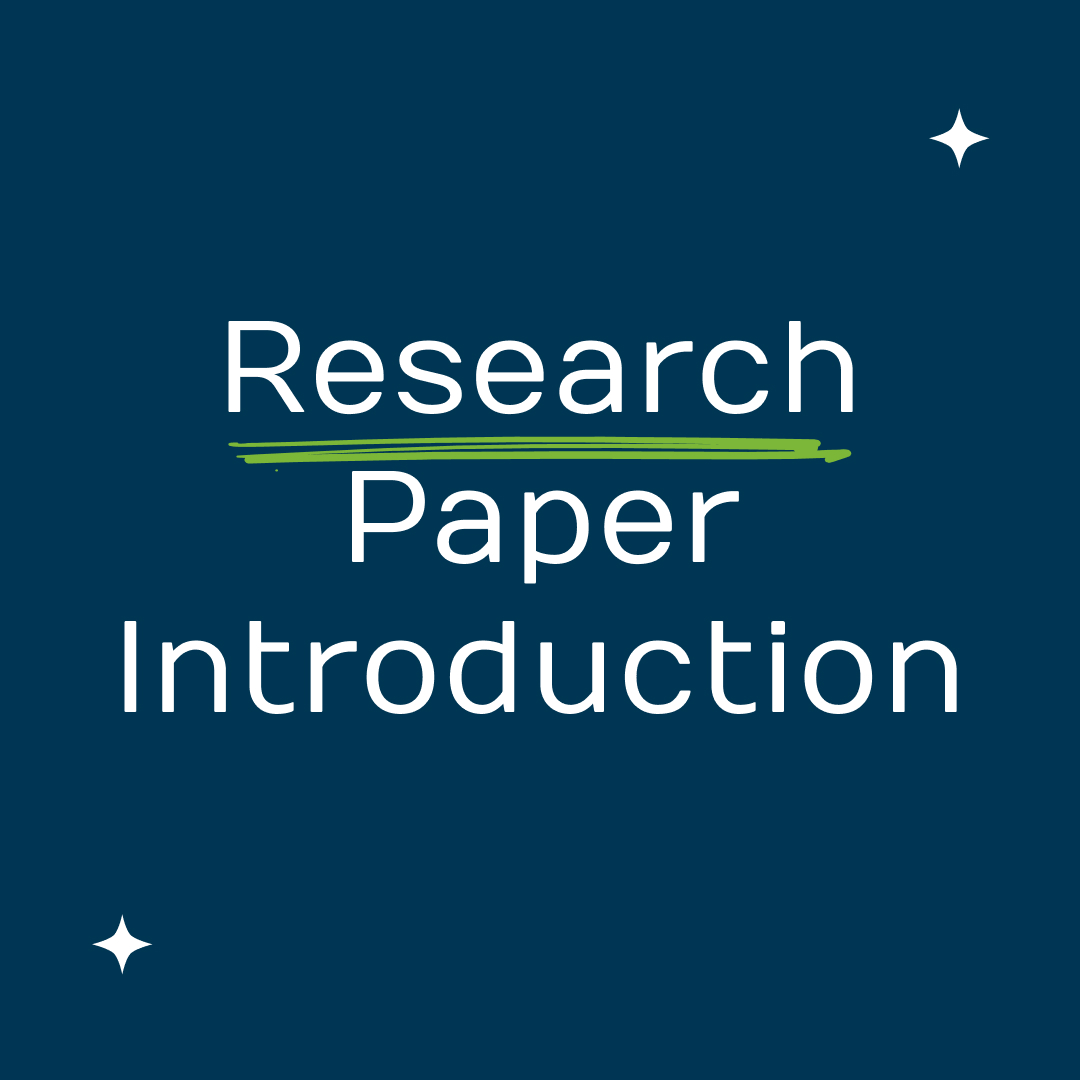
An introductory paragraph is vital for any academic paper. It allows you to show reviewers why your research topic is worth reading about. In this article, we will explore the tips to make a good introduction paragraph. You’ll get a step-by-step tutorial on writing your paper’s informative yet laconic intro.
What is the purpose of an introduction?
The purpose of a research paper intro is to provide an overview and context for the study being conducted. A research paper engages the reader, establishes the importance of the research topic, and outlines the study’s objectives and scope.
The paper intro also presents the question or hypothesis and summarizes relevant background characteristics and existing literature.
An effective introduction helps the reader understand the significance and relevance of the research paper and sets the stage for the subsequent sections. The introduction captures the reader’s attention and creates a foundation for understanding the research and its contributions.
The key elements of a scientific paper introduction
The introduction of your research paper should include several key elements, including the problem statement, hypothesis/thesis/research question, purpose, and background.
Let’s explore each of these parts of the research paper intro in detail:
- Problem Statement : identifies the specific issue or gap in knowledge that the research paper aims to address. It highlights the problem’s relevance, significance, and potential impact on the field of study. The problem statement sets the stage for the research by clearly stating the project or research gap.
- Hypothesis / Thesis / Research Question : a paper hypothesis predicts the relationship between variables, a thesis statement presents the main argument or claim, and a research question seeks to put a specific aspect on a research paper.
- Purpose: describes the overall objective or goal the research paper aims to achieve. It outlines the researcher’s intention and provides a clear direction for the investigation. The purpose statement typically explains why the research is being conducted and what the researcher hopes to accomplish by the end of the study.
- Background : provides the necessary context and information to familiarize readers with the research paper. It presents a concise review of the relevant literature, previous studies, and theoretical frameworks that have shaped the understanding of the problem.
Shortly, the introduction section of a research paper combines these key elements to introduce the problem, state the hypothesis/thesis/research question, define the paper’s purpose, and provide the background necessary for readers to understand the significance and context of the study.
How to write an effective intro?
To start an introduction for a research paper, consider the following steps:
- Hook the reader : begin with a compelling opening sentence or a thought-provoking statement that grabs the reader’s attention. This could be an interesting fact, a relevant anecdote, or a surprising statistic related to your research paper.
- Provide background information : offer a brief overview of the paper and its significance in the field. This helps to improve the structure of an introduction and demonstrate why it is important to investigate the point further in a paper.
- State the problem : clearly articulate the problem statement or research gap your study aims to address. Explain the specific issue or gap in knowledge that your research paper seeks to explore, emphasizing its relevance and potential impact.
- Present the research question/hypothesis/thesis : formulate a concise and focused research question, hypothesis, or thesis statement in the intro that guides your scientific paper. This sets the direction for your research and provides a clear focus for the reader.
- Outline the purpose and objectives : explain the overall purpose of your research paper and the specific objectives you aim to achieve. This helps readers understand why your study is being conducted and what you hope to accomplish.
- Preview the structure : briefly introduce the organization and structure of your research paper. Mention the main sections or components that will be covered, giving readers a sense of what to expect as they continue reading the paper.
Remember, the intro should be concise and engaging, providing a clear roadmap for your research and capturing the reader’s interest from the very beginning. There are different ways to start a research paper, and you can pick the intro that suits you best.
Writing an introduction to a research paper: key steps
Here’s a short guide on getting you started with an introduction:
- Start with an attention-grabbing opening : begin your intro with a captivating statement, a relevant quote, a surprising fact, or an intriguing anecdote. This will engage the reader’s interest and make them curious about your research paper.
- Provide background information : write a brief overview of the research topic to provide context and establish the importance of the subject matter. Discuss key concepts, definitions, or historical background relevant to your study. This section should help the reader understand the broader context of your research paper.
- State the research problem or gap : clearly define the specific problem or research gap your study aims to address. Explain why this problem is significant and deserving of investigation. This helps the reader understand the purpose and relevance of your research paper.
- Present your research question or thesis statement : formulate a clear and concise research question, hypothesis, or thesis statement that serves as the central focus of your study. This statement should guide your research paper and articulate your introduction format.
- Outline the structure of the paper : write a brief preview of your research paper’s main sections and organization. This helps the reader understand the flow of your paper and what to expect in each section. Provide a roadmap by mentioning the key points or arguments discussed in subsequent sections.
By following these steps, you can create an introduction that grabs the reader’s attention and sets the stage for the rest of your research paper, clearly understanding your study’s problem, purpose, and structure.
Writing a checklist for a proper college paper introduction
Here’s a short writing checklist for a research paper intro:
- Attention-grabbing opening:
- Does the research paper introduction example start with a compelling statement, relevant quote, surprising fact, or intriguing anecdote?
- Is the opening engaging enough to capture readers’ attention and make them curious about the research paper?
- Background information:
- Have you provided a concise overview of the research topic, including relevant definitions, concepts, or historical context?
- Does the background information help the reader understand the broader context and importance of the subject matter?
- Clear problem statement:
- Have you clearly stated the specific problem or research gap that your study aims to address?
- Does a research introduction have a well-defined, strong, and significant problem statement?
- Research question or thesis statement:
- Have you presented a clear and concise research question, hypothesis, or thesis statement that guides your paper?
- Does the research question or thesis statement align with the problem statement and set the direction for your research paper?
- Structure and organization:
- Did you write a brief overview of the structure and organization of the research paper?
- Does the introduction outline the main sections or components covered in the paper?
- Coherence and flow:
- Is the intro logically organized? Does it have smooth transitions between ideas and paragraphs?
- Does the intro flow smoothly from the opening to the problem statement, research question, and purpose?
- Conciseness and clarity:
- Have you kept the introduction concise, avoiding unnecessary details or tangents?
- Is the language clear, avoiding jargon or overly technical terms that may confuse the reader?
- Relevance and significance:
- Have you clearly explained the relevance and significance of the research topic and the paper’s potential impact?
- Does the introduction effectively communicate why your research is important and worth exploring?
This checklist will help you to review your research essay introduction to ensure it effectively grabs the reader’s attention, provides necessary background information, states the problem clearly, presents a focused research question or thesis statement, outlines the structure of the paper, and maintains coherence and clarity throughout.
Types of intro formats
Different academic disciplines may follow specific formatting styles for research introduction, such as MLA (Modern Language Association), APA (American Psychological Association), Chicago, ASA (American Sociological Association), and AMA (American Medical Association).

To write an introduction paragraph, you should understand the differences between the most common academic formats for your future paper.
MLA (Modern Language Association):
- Primarily used in humanities, literature, and arts disciplines.
- Features in-text citations using the author-page format (e.g., “Smith 45”).
APA (American Psychological Association):
- Commonly used in social sciences, psychology, and education.
- Utilizes in-text citations with the author-date format (e.g., “Smith, 2019”).
- Often used in history, humanities, and some social sciences.
- Offers two styles: the notes-bibliography system and the author-date system.
- Includes a bibliography page to list all sources used.
ASA (American Sociological Association):
- Primarily used in sociology and related social sciences.
- Utilizes in-text citations with the author-date format (e.g., “Smith 2019”).
AMA (American Medical Association):
- Commonly used in medical, health, and biological sciences.
- Features in-text citations with a superscript number (e.g., “Smith^1”).
- Emphasizes accuracy and consistency in citation style.
All formatting styles mean a set of rules and guidelines for citing sources, formatting headings, page layout, and referencing. It’s important to consult the specific style guide or manual associated with your field of study before you write.
These might include guidelines provided by your institution to ensure proper paper formatting and adherence of a research introduction to the chosen style.
Research introduction sample
Now that you know how the idea goes in the introduction of a research paper, let’s see the practical examples of good and bad introductions and discuss their differences.
Good example:
Title: “Exploring the Impact of Climate Change on Biodiversity: A Comprehensive Analysis”
Introduction:
Climate change is a pressing global issue that has far-reaching consequences for our planet. Its effects on various ecosystems, particularly biodiversity loss, have attracted significant attention from researchers and policymakers alike.
This research paper aims to provide a comprehensive analysis of the impact of climate change on biodiversity, focusing on key regions and species vulnerable to these changes. By examining the latest scientific literature, empirical studies, and expert opinions, we will explore the complex interplay between climate change and biodiversity loss, shed light on the underlying mechanisms, and propose potential mitigation strategies.
Understanding these dynamics is crucial for developing effective conservation strategies and promoting sustainable practices that will help preserve our planet’s invaluable natural heritage.
Bad example:
Title: “Climate Change and Biodiversity”
Climate change and biodiversity are two important topics that have received considerable attention recently. Climate change refers to the long-term alteration of temperature and precipitation patterns, while biodiversity encompasses the variety of life forms found on Earth.
In this research paper, we will discuss the impact of climate change on biodiversity and explore various examples and case studies. The paper will also highlight the significance of addressing this issue and present potential solutions.
By delving into this subject, we aim to contribute to the existing body of knowledge and raise awareness about the importance of protecting biodiversity in climate change.
To begin an introduction paragraph, don’t provide too much background or theory at once. Remember to arrange your thoughts concisely while keeping the important information for the paper body.
A good intro should answer the four basic questions:
- What was I studying?
- Why was this topic important to investigate?
- What did we know about this topic before I did this study?
- How will this study advance our knowledge?
Remember that you might not get a second chance to create a positive first impression. That’s why it’s equally important to keep your paper laconic and to end an introduction paragraph with a call to action to read your research paper.

- Writing a Research Paper
- Research Paper Title
- Research Paper Sources
- Research Paper Problem Statement
- Research Paper Thesis Statement
- Hypothesis for a Research Paper
- Research Question
- Research Paper Outline
- Research Paper Summary
- Research Paper Prospectus
- Research Paper Proposal
- Research Paper Format
- Research Paper Styles
- AMA Style Research Paper
- MLA Style Research Paper
- Chicago Style Research Paper
- APA Style Research Paper
- Research Paper Structure
- Research Paper Cover Page
- Research Paper Abstract
- Research Paper Introduction
- Research Paper Body Paragraph
- Research Paper Literature Review
- Research Paper Background
- Research Paper Methods Section
- Research Paper Results Section
- Research Paper Discussion Section
- Research Paper Conclusion
- Research Paper Appendix
- Research Paper Bibliography
- APA Reference Page
- Annotated Bibliography
- Bibliography vs Works Cited vs References Page
- Research Paper Types
- What is Qualitative Research
Receive paper in 3 Hours!
- Choose the number of pages.
- Select your deadline.
- Complete your order.
Number of Pages
550 words (double spaced)
Deadline: 10 days left
By clicking "Log In", you agree to our terms of service and privacy policy . We'll occasionally send you account related and promo emails.
Sign Up for your FREE account
Purdue Online Writing Lab Purdue OWL® College of Liberal Arts
Writing a Research Paper

Welcome to the Purdue OWL
This page is brought to you by the OWL at Purdue University. When printing this page, you must include the entire legal notice.
Copyright ©1995-2018 by The Writing Lab & The OWL at Purdue and Purdue University. All rights reserved. This material may not be published, reproduced, broadcast, rewritten, or redistributed without permission. Use of this site constitutes acceptance of our terms and conditions of fair use.
The Research Paper
There will come a time in most students' careers when they are assigned a research paper. Such an assignment often creates a great deal of unneeded anxiety in the student, which may result in procrastination and a feeling of confusion and inadequacy. This anxiety frequently stems from the fact that many students are unfamiliar and inexperienced with this genre of writing. Never fear—inexperience and unfamiliarity are situations you can change through practice! Writing a research paper is an essential aspect of academics and should not be avoided on account of one's anxiety. In fact, the process of writing a research paper can be one of the more rewarding experiences one may encounter in academics. What is more, many students will continue to do research throughout their careers, which is one of the reasons this topic is so important.
Becoming an experienced researcher and writer in any field or discipline takes a great deal of practice. There are few individuals for whom this process comes naturally. Remember, even the most seasoned academic veterans have had to learn how to write a research paper at some point in their career. Therefore, with diligence, organization, practice, a willingness to learn (and to make mistakes!), and, perhaps most important of all, patience, students will find that they can achieve great things through their research and writing.
The pages in this section cover the following topic areas related to the process of writing a research paper:
- Genre - This section will provide an overview for understanding the difference between an analytical and argumentative research paper.
- Choosing a Topic - This section will guide the student through the process of choosing topics, whether the topic be one that is assigned or one that the student chooses themselves.
- Identifying an Audience - This section will help the student understand the often times confusing topic of audience by offering some basic guidelines for the process.
- Where Do I Begin - This section concludes the handout by offering several links to resources at Purdue, and also provides an overview of the final stages of writing a research paper.

- Langson Library
- Science Library
- Grunigen Medical Library
- Law Library
- Connect From Off-Campus
- Accessibility
- Gateway Study Center

Email this link
Writing a scientific paper.
- Writing a lab report
What is a "good" introduction?
Citing sources in the introduction, "introduction checklist" from: how to write a good scientific paper. chris a. mack. spie. 2018..
- LITERATURE CITED
- Bibliography of guides to scientific writing and presenting
- Peer Review
- Presentations
- Lab Report Writing Guides on the Web
This is where you describe briefly and clearly why you are writing the paper. The introduction supplies sufficient background information for the reader to understand and evaluate the experiment you did. It also supplies a rationale for the study.
- Present the problem and the proposed solution
- Presents nature and scope of the problem investigated
- Reviews the pertinent literature to orient the reader
- States the method of the experiment
- State the principle results of the experiment
It is important to cite sources in the introduction section of your paper as evidence of the claims you are making. There are ways of citing sources in the text so that the reader can find the full reference in the literature cited section at the end of the paper, yet the flow of the reading is not badly interrupted. Below are some example of how this can be done: "Smith (1983) found that N-fixing plants could be infected by several different species of Rhizobium." "Walnut trees are known to be allelopathic (Smith 1949, Bond et al. 1955, Jones and Green 1963)." "Although the presence of Rhizobium normally increases the growth of legumes (Nguyen 1987), the opposite effect has been observed (Washington 1999)." Note that articles by one or two authors are always cited in the text using their last names. However, if there are more than two authors, the last name of the 1st author is given followed by the abbreviation et al. which is Latin for "and others".
From: https://writingcenter.gmu.edu/guides/imrad-reports-introductions
- Indicate the field of the work, why this field is important, and what has already been done (with proper citations).
- Indicate a gap, raise a research question, or challenge prior work in this territory.
- Outline the purpose and announce the present research, clearly indicating what is novel and why it is significant.
- Avoid: repeating the abstract; providing unnecessary background information; exaggerating the importance of the work; claiming novelty without a proper literature search.
- << Previous: ABSTRACT
- Next: METHODS >>
- Last Updated: Aug 4, 2023 9:33 AM
- URL: https://guides.lib.uci.edu/scientificwriting
Off-campus? Please use the Software VPN and choose the group UCIFull to access licensed content. For more information, please Click here
Software VPN is not available for guests, so they may not have access to some content when connecting from off-campus.

Get science-backed answers as you write with Paperpal's Research feature
How to Write an Abstract in Research Papers (with Examples)

An abstract in research papers is a keyword-rich summary usually not exceeding 200-350 words. It can be considered the “face” of research papers because it creates an initial impression on the readers. While searching databases (such as PubMed) for research papers, a title is usually the first selection criterion for readers. If the title matches their search criteria, then the readers read the abstract, which sets the tone of the paper. Titles and abstracts are often the only freely available parts of research papers on journal websites. The pdf versions of full articles need to be purchased. Journal reviewers are often provided with only the title and abstract before they agree to review the complete paper. [ 1]
Abstracts in research papers provide readers with a quick insight into what the paper is about to help them decide whether they want to read it further or not. Abstracts are the main selling points of articles and therefore should be carefully drafted, accurately highlighting the important aspects. [ 2]
This article will help you identify the important components and provide tips on how to write an abstract in research papers effectively
What is an Abstract?
An abstract in research papers can be defined as a synopsis of the paper. It should be clear, direct, self-contained, specific, unbiased, and concise. These summaries are published along with the complete research paper and are also submitted to conferences for consideration for presentation.
Abstracts are of four types and journals can follow any of these formats: [ 2]
- Structured
- Unstructured
- Descriptive
- Informative
Structured abstracts are used by most journals because they are more organized and have clear sections, usually including introduction/background; objective; design, settings, and participants (or materials and methods); outcomes and measures; results; and conclusion. These headings may differ based on the journal or the type of paper. Clinical trial abstracts should include the essential items mentioned in the CONSORT (Consolidated Standards Of Reporting Trials) guidelines.

Figure 1. Structured abstract example [3]
Unstructured abstracts are common in social science, humanities, and physical science journals. They usually have one paragraph and no specific structure or subheadings. These abstracts are commonly used for research papers that don’t report original work and therefore have a more flexible and narrative style.

Figure 2. Unstructured abstract example [3]
Descriptive abstracts are short (75–150 words) and provide an outline with only the most important points of research papers. They are used for shorter articles such as case reports, reviews, and opinions where space is at a premium, and rarely for original investigations. These abstracts don’t present the results but mainly list the topics covered.
Here’s a sample abstract . [ 4]
“Design of a Radio-Based System for Distribution Automation”
A new survey by the Maryland Public Utilities Commission suggests that utilities have not effectively explained to consumers the benefits of smart meters. The two-year study of 86,000 consumers concludes that the long-term benefits of smart meters will not be realized until consumers understand the benefits of shifting some of their power usage to off-peak hours in response to the data they receive from their meters. The study presents recommendations for utilities and municipal governments to improve customer understanding of how to use the smart meters effectively.
Keywords: smart meters, distribution systems, load, customer attitudes, power consumption, utilities
Informative abstracts (structured or unstructured) give a complete detailed summary, including the main results, of the research paper and may or may not have subsections.

Figure 3. Informative abstract example [5]
Purpose of Abstracts in Research
Abstracts in research have two main purposes—selection and indexing. [ 6,7]
- Selection : Abstracts allow interested readers to quickly decide the relevance of a paper to gauge if they should read it completely.
- Indexing : Most academic journal databases accessed through libraries enable you to search abstracts, allowing for quick retrieval of relevant articles and avoiding unnecessary search results. Therefore, abstracts must necessarily include the keywords that researchers may use to search for articles.
Thus, a well-written, keyword-rich abstract can p ique readers’ interest and curiosity and help them decide whether they want to read the complete paper. It can also direct readers to articles of potential clinical and research interest during an online search.

Contents of Abstracts in Research
Abstracts in research papers summarize the main points of an article and are broadly categorized into four or five sections. Here are some details on how to write an abstract .
Introduction/Background and/or Objectives
This section should provide the following information:
- What is already known about the subject?
- What is not known about the subject or what does the study aim to investigate?
The hypothesis or research question and objectives should be mentioned here. The Background sets the context for the rest of the paper and its length should be short so that the word count could be saved for the Results or other information directly pertaining to the study. The objective should be written in present or past simple tense.
Examples:
The antidepressant efficacy of desvenlafaxine (DV) has been established in 8-week, randomized controlled trials. The present study examined the continued efficacy of DV across 6 months of maintenance treatment . [ 1]
Objective: To describe gastric and breast cancer risk estimates for individuals with CDH1 variants.
Design, Setting, and Participants (or Materials and Methods)
This section should provide information on the processes used and should be written in past simple tense because the process is already completed.
A few important questions to be answered include:
- What was the research design and setting?
- What was the sample size and how were the participants sampled?
- What treatments did the participants receive?
- What were the data collection and data analysis dates?
- What was the primary outcome measure?
Hazard ratios (HRs) were estimated for each cancer type and used to calculate cumulative risks and risks per decade of life up to age 80 years.

This section, written in either present or past simple tense, should be the longest and should describe the main findings of the study. Here’s an example of how descriptive the sentences should be:
Avoid: Response rates differed significantly between diabetic and nondiabetic patients.
Better: The response rate was higher in nondiabetic than in diabetic patients (49% vs 30%, respectively; P<0.01).
This section should include the following information:
- Total number of patients (included, excluded [exclusion criteria])
- Primary and secondary outcomes, expressed in words, and supported by numerical data
- Data on adverse outcomes
Example: [ 8]
In total, 10.9% of students were reported to have favorable study skills. The minimum score was found for preparation for examination domain. Also, a significantly positive correlation was observed between students’ study skills and their Grade Point Average (GPA) of previous term (P=0.001, r=0.269) and satisfaction with study skills (P=0.001, r=0.493).
Conclusions
Here, authors should mention the importance of their findings and also the practical and theoretical implications, which would benefit readers referring to this paper for their own research. Present simple tense should be used here.
Examples: [ 1,8]
The 9.3% prevalence of bipolar spectrum disorders in students at an arts university is substantially higher than general population estimates. These findings strengthen the oft-expressed hypothesis linking creativity with affective psychopathology.
The findings indicated that students’ study skills need to be improved. Given the significant relationship between study skills and GPA, as an index of academic achievement, and satisfaction, it is necessary to promote the students’ study skills. These skills are suggested to be reinforced, with more emphasis on weaker domains.

When to Write an Abstract
In addition to knowing how to write an abstract , you should also know when to write an abstract . It’s best to write abstracts once the paper is completed because this would make it easier for authors to extract relevant parts from every section.
Abstracts are usually required for: [ 7]
- submitting articles to journals
- applying for research grants
- writing book proposals
- completing and submitting dissertations
- submitting proposals for conference papers
Mostly, the author of the entire work writes the abstract (the first author, in works with multiple authors). However, there are professional abstracting services that hire writers to draft abstracts of other people’s work.
How to Write an Abstract (Step-by-Step Process)
Here are some key steps on how to write an abstract in research papers: [ 9]
- Write the abstract after you’ve finished writing your paper.
- Select the major objectives/hypotheses and conclusions from your Introduction and Conclusion sections.
- Select key sentences from your Methods section.
- Identify the major results from the Results section.
- Paraphrase or re-write the sentences selected in steps 2, 3, and 4 in your own words into one or two paragraphs in the following sequence: Introduction/Objective, Methods, Results, and Conclusions. The headings may differ among journals, but the content remains the same.
- Ensure that this draft does not contain: a. new information that is not present in the paper b. undefined abbreviations c. a discussion of previous literature or reference citations d. unnecessary details about the methods used
- Remove all extra information and connect your sentences to ensure that the information flows well, preferably in the following order: purpose; basic study design, methodology and techniques used; major findings; summary of your interpretations, conclusions, and implications. Use section headings for structured abstracts.
- Ensure consistency between the information presented in the abstract and the paper.
- Check to see if the final abstract meets the guidelines of the target journal (word limit, type of abstract, recommended subheadings, etc.) and if all the required information has been included.
Choosing Keywords for Abstracts
Keywords [ 2] are the important and repeatedly used words and phrases in research papers and can help indexers and search engines find papers relevant to your requirements. Easy retrieval would help in reaching a wider audience and eventually gain more citations. In the fields of medicine and health, keywords should preferably be chosen from the Medical Subject Headings (MeSH) list of the US National Library of Medicine because they are used for indexing. These keywords need to be different from the words in the main title (automatically used for indexing) but can be variants of the terms/phrases used in the title, abstract, and the main text. Keywords should represent the content of your manuscript and be specific to your subject area.
Basic tips for authors [ 10,11]
- Read through your paper and highlight key terms or phrases that are most relevant and frequently used in your field, to ensure familiarity.
- Several journals provide instructions about the length (eg, 3 words in a keyword) and maximum number of keywords allowed and other related rules. Create a list of keywords based on these instructions and include specific phrases containing 2 to 4 words. A longer string of words would yield generic results irrelevant to your field.
- Use abbreviations, acronyms, and initializations if these would be more familiar.
- Search with your keywords to ensure the results fit with your article and assess how helpful they would be to readers.
- Narrow down your keywords to about five to ten, to ensure accuracy.
- Finalize your list based on the maximum number allowed.
Few examples: [ 12]
| Direct observation of nonlinear optics in an isolated carbon nanotube | molecule, optics, lasers, energy lifetime | single-molecule interaction, Kerr effect, carbon nanotube, energy level |
| Region-specific neuronal degeneration after okadaic acid administration | neuron, brain, regional-specific neuronal degeneration, signaling | neurodegenerative diseases; CA1 region, hippocampal; okadaic acid; neurotoxins; MAP kinase signaling system; cell death |
| Increases in levels of sediment transport at former glacial-interglacial transitions | climate change, erosion, plant effects | quaternary climate change, soil erosion, bioturbation |
Important Tips for Writing an Abstract
Here are a few tips on how to write an abstract to ensure that your abstract is complete, concise, and accurate. [ 1,2]
- Write the abstract last.
- Follow journal-specific formatting guidelines or Instructions to Authors strictly to ensure acceptance for publication.
- Proofread the final draft meticulously to avoid grammatical or typographical errors.
- Ensure that the terms or data mentioned in the abstract are consistent with the main text.
- Include appropriate keywords at the end.
Do not include:
- New information
- Text citations to references
- Citations to tables and figures
- Generic statements
- Abbreviations unless necessary, like a trial or study name

Key Takeaways
Here’s a quick snapshot of all the important aspects of how to write an abstract . [2]
- An abstract in research is a summary of the paper and describes only the main aspects. Typically, abstracts are about 200-350 words long.
- Abstracts are of four types—structured, unstructured, descriptive, and informative.
- Abstracts should be simple, clear, concise, independent, and unbiased (present both favorable and adverse outcomes).
- They should adhere to the prescribed journal format, including word limits, section headings, number of keywords, fonts used, etc.
- The terminology should be consistent with the main text.
- Although the section heading names may differ for journals, every abstract should include a background and objective, analysis methods, primary results, and conclusions.
- Nonstandard abbreviations, references, and URLs shouldn’t be included.
- Only relevant and specific keywords should be used to ensure focused searches and higher citation frequency.
- Abstracts should be written last after completing the main paper.
Frequently Asked Questions
Q1. Do all journals have different guidelines for abstracts?
A1. Yes, all journals have their own specific guidelines for writing abstracts; a few examples are given in the following table. [ 6,13,14,15]
| American Psychological Association | |
| American Society for Microbiology | |
| The Lancet | |
| Journal of the American Medical Association |
Q2. What are the common mistakes to avoid when writing an abstract?
A2. Listed below are a few mistakes that authors may make inadvertently while writing abstracts.
- Copying sentences from the paper verbatim
An abstract is a summary, which should be created by paraphrasing your own work or writing in your own words. Extracting sentences from every section and combining them into one paragraph cannot be considered summarizing.
- Not adhering to the formatting guidelines
Journals have special instructions for writing abstracts, such as word limits and section headings. These should be followed strictly to avoid rejections.
- Not including the right amount of details in every section
Both too little and too much information could discourage readers. For instance, if the Background has very little information, the readers may not get sufficient context to appreciate your research. Similarly, incomplete information in the Methods and a text-heavy Results section without supporting numerical data may affect the credibility of your research.
- Including citations, standard abbreviations, and detailed measurements
Typically, abstracts shouldn’t include these elements—citations, URLs, and abbreviations. Only nonstandard abbreviations are allowed or those that would be more familiar to readers than the expansions.
- Including new information
Abstracts should strictly include only the same information mentioned in the main text. Any new information should first be added to the text and then to the abstract only if necessary or if permitted by the word limit.
- Not including keywords
Keywords are essential for indexing and searching and should be included to increase the frequency of retrieval and citation.
Q3. What is the difference between abstracts in research papers and conference abstracts? [16]
A3. The table summarizes the main differences between research and conference abstracts.
| Context | Concise summary of ongoing or completed research presented at conferences | Summary of full research paper published in a journal |
| Length | Shorter (150-250 words) | Longer (150-350 words) |
| Audience | Diverse conference attendees (both experts & people with general interest) | People or other researchers specifically interested in the subject |
| Focus | Intended to quickly attract interest; provides just enough information to highlight the significance, objectives, and impact; may briefly state methods and results | Deeper insight into the study; more detailed sections on methodology, results, and broader implications |
| Publication venue | Not published independently but included in conference schedules, booklets, etc. | Published with the full research paper in academic journals, conference proceedings, research databases, etc. |
| Citations | Allowed | Not allowed |
Thus, abstracts are essential “trailers” that can market your research to a wide audience. The better and more complete the abstract the more are the chances of your paper being read and cited. By following our checklist and ensuring that all key elements are included, you can create a well-structured abstract that summarizes your paper accurately.
References
- Andrade C. How to write a good abstract for a scientific paper or conference presentation. Indian J Psychiatry . 2011; 53(2):172-175. Accessed June 14, 2024. https://www.ncbi.nlm.nih.gov/pmc/articles/PMC3136027/
- Tullu MS. Writing the title and abstract for a research paper: Being concise, precise, and meticulous is the key. 2019; 13(Suppl 1): S12-S17. Accessed June 14, 2024. https://www.ncbi.nlm.nih.gov/pmc/articles/PMC6398294/
- Zawia J. Writing an Academic Paper? Get to know Abstracts vs. Structured Abstracts. Medium. Published October 16, 2023. Accessed June 16, 2024. https://medium.com/@jamala.zawia/writing-an-academic-paper-get-to-know-abstracts-vs-structured-abstracts-11ed86888367
- Markel M and Selber S. Technical Communication, 12 th edition. 2018; pp. 482. Bedford/St Martin’s.
- Abstracts. Arkansas State University. Accessed June 17, 2024. https://www.astate.edu/a/global-initiatives/online/a-state-online-services/online-writing-center/resources/How%20to%20Write%20an%20Abstract1.pdf
- AMA Manual of Style. 11 th edition. Oxford University Press.
- Writing an Abstract. The University of Melbourne. Accessed June 16, 2024. https://services.unimelb.edu.au/__data/assets/pdf_file/0007/471274/Writing_an_Abstract_Update_051112.pdf
- 10 Good Abstract Examples that will Kickstart Your Brain. Kibin Essay Writing Blog. Published April 5, 2017. Accessed June 17, 2024. https://www.kibin.com/essay-writing-blog/10-good-abstract-examples/
- A 10-step guide to make your research paper abstract more effective. Editage Insights. Published October 16, 2013. Accessed June 17, 2024. https://www.editage.com/insights/a-10-step-guide-to-make-your-research-paper-abstract-more-effective
- Using keywords to write your title and abstract. Taylor & Francis Author Services. Accessed June 15, 2024. https://authorservices.taylorandfrancis.com/publishing-your-research/writing-your-paper/using-keywords-to-write-title-and-abstract/
- How to choose and use keywords in research papers. Paperpal by Editage blog. Published March 10, 2023. Accessed June 17, 2024. https://paperpal.com/blog/researcher-resources/phd-pointers/how-to-choose-and-use-keywords-in-research-papers
- Title, abstract and keywords. Springer. Accessed June 16, 2024. https://www.springer.com/it/authors-editors/authorandreviewertutorials/writing-a-journal-manuscript/title-abstract-and-keywords/10285522
- Abstract and keywords guide. APA Style, 7 th edition. Accessed June 18, 2024. https://apastyle.apa.org/instructional-aids/abstract-keywords-guide.pdf
- Abstract guidelines. American Society for Microbiology. Accessed June 18, 2024. https://asm.org/events/asm-microbe/present/abstract-guidelines
- Guidelines for conference abstracts. The Lancet. Accessed June 16, 2024. https://www.thelancet.com/pb/assets/raw/Lancet/pdfs/Abstract_Guidelines_2013.pdf
- Is a conference abstract the same as a paper abstract? Global Conference Alliance, Inc. Accessed June 18, 2024. https://globalconference.ca/is-a-conference-abstract-the-same-as-a-paper-abstract/
Paperpal is a comprehensive AI writing toolkit that helps students and researchers achieve 2x the writing in half the time. It leverages 21+ years of STM experience and insights from millions of research articles to provide in-depth academic writing, language editing, and submission readiness support to help you write better, faster.
Get accurate academic translations, rewriting support, grammar checks, vocabulary suggestions, and generative AI assistance that delivers human precision at machine speed. Try for free or upgrade to Paperpal Prime starting at US$19 a month to access premium features, including consistency, plagiarism, and 30+ submission readiness checks to help you succeed.
Experience the future of academic writing – Sign up to Paperpal and start writing for free!
Related Reads:
- What are Journal Guidelines on Using Generative AI Tools
- How to Write a High-Quality Conference Paper
How to Write Dissertation Acknowledgements?
- How to Write the First Draft of a Research Paper with Paperpal?
Top 7 AI Tools for Research 2024
You may also like, maintaining academic integrity with paperpal’s generative ai writing..., research funding basics: what should a grant proposal..., how to structure an essay, leveraging generative ai to enhance student understanding of..., how to write a good hook for essays,..., addressing peer review feedback and mastering manuscript revisions..., how paperpal can boost comprehension and foster interdisciplinary..., what is the importance of a concept paper..., how to write the first draft of a....
Free All-in-One Office Suite with PDF Editor
Edit Word, Excel, and PPT for FREE.
Read, edit, and convert PDFs with the powerful PDF toolkit.
Microsoft-like interface, easy to use.
Windows • MacOS • Linux • iOS • Android

Select areas that need to improve
- Didn't match my interface
- Too technical or incomprehensible
- Incorrect operation instructions
- Incomplete instructions on this function
Fields marked * are required please
Please leave your suggestions below
- Quick Tutorials
- Practical Skills
How to Write a Research Paper [Steps & Examples]
As a student, you are often required to complete numerous academic tasks, which can demand a lot of extra effort. Writing a research paper is one of these tasks. If researching for the topic isn't challenging enough, writing it down in a specific format adds another layer of difficulty. Having gone through this myself, I want to help you have a smoother journey in writing your research paper. I'll guide you through everything you need to know about writing a research paper, including how to write a research paper and all the necessary factors you need to consider while writing one.
Order for Preparation of your research paper
Before beginning your research paper, start planning how you will organize your paper. Follow the specific order I have laid out to ensure you assemble everything correctly, cover all necessary components, and write more effectively. This method will help you avoid missing important elements and improve the overall quality of your paper.
Figures and Tables
Assemble all necessary visual aids to support your data and findings. Ensure they are labeled correctly and referenced appropriately in your text.
Detail the procedures and techniques used in your research. This section should be thorough enough to allow others to replicate your study.
Summarize the findings of your research without interpretation. Use figures and tables to illustrate your data clearly.
Interpret the results, discussing their implications and how they relate to your research question. Address any limitations and suggest areas for future research.
Summarize the key points of your research, restating the significance of your findings and their broader impact.
Introduction
Introduce the topic, provide background information, and state the research problem or hypothesis. Explain the purpose and scope of your study.
Write a concise summary of your research, including the objective, methods, results, and conclusion. Keep it brief and to the point.
Create a clear and informative title that accurately reflects the content and focus of your research paper.
Identify key terms related to your research that will help others find your paper in searches.
Acknowledgements
Thank those who contributed to your research, including funding sources, advisors, and any other significant supporters.
Compile a complete list of all sources cited in your paper, formatted according to the required citation style. Ensure every reference is accurate and complete.
Types of Research Papers
There are multiple types of research papers, each with distinct characteristics, purposes, and structures. Knowing which type of research paper is required for your assignment is crucial, as each demands different preparation and writing strategies. Here, we will delve into three prominent types: argumentative, analytical, and compare and contrast papers. We will discuss their characteristics, suitability, and provide detailed examples to illustrate their application.
A.Argumentative Papers
Characteristics:
An argumentative or persuasive paper is designed to present a balanced view of a controversial issue, but ultimately aims to persuade the reader to adopt the writer's perspective. The key characteristics of this type of paper include:
Purpose: The primary goal is to convince the reader to support a particular stance on an issue. This is achieved by presenting arguments, evidence, and refuting opposing viewpoints.
Structure: Typically structured into an introduction, a presentation of both sides of the issue, a refutation of the opposing arguments, and a conclusion that reinforces the writer’s position.
Tone: While the tone should be logical and factual, it should not be overly emotional. Arguments must be supported with solid evidence, such as statistics, expert opinions, and factual data.
Suitability:
Argumentative papers are suitable for topics that have clear, opposing viewpoints. They are often used in debates, policy discussions, and essays aimed at influencing public opinion or academic discourse.
Topic: "Should governments implement universal basic income?"
Pro Side: Universal basic income provides financial security, reduces poverty, and can lead to a more equitable society.
Con Side: It could discourage work, lead to higher government expenditure, and might not be a sustainable long-term solution.
Argument: After presenting both sides, the paper would argue that the benefits of reducing poverty and financial insecurity outweigh the potential drawbacks, using evidence from various studies and real-world examples.
Writing Tips:
Clearly articulate your position on the issue from the beginning.
Present balanced arguments by including credible sources that support both sides.
Refute counterarguments effectively with logical reasoning and evidence.
Maintain a factual and logical tone, avoiding excessive emotional appeals.
B.Analytical Papers
An analytical research paper is focused on breaking down a topic into its core components, examining various perspectives, and drawing conclusions based on this analysis. The main characteristics include:
Purpose: To pose a research question, collect data from various sources, analyze different viewpoints, and synthesize the information to arrive at a personal conclusion.
Structure: Includes an introduction with a clear research question, a literature review that summarizes existing research, a detailed analysis, and a conclusion that summarizes findings.
Tone: Objective and neutral, avoiding personal bias or opinion. The focus is on data and logical analysis.
Analytical research papers are ideal for topics that require detailed examination and evaluation of various aspects. They are common in disciplines such as social sciences, humanities, and natural sciences, where deep analysis of existing research is crucial.
Topic: "The impact of social media on mental health."
Research Question: How does social media usage affect mental well-being among teenagers?
Analysis: Examine studies that show both positive (e.g., social support) and negative (e.g., anxiety and depression) impacts of social media. Analyze the methodologies and findings of these studies.
Conclusion: Based on the analysis, conclude whether the overall impact is more beneficial or harmful, remaining neutral and presenting evidence without personal bias.
Maintain an objective and neutral tone throughout the paper.
Synthesize information from multiple sources, ensuring a comprehensive analysis.
Develop a clear thesis based on the findings from your analysis.
Avoid inserting personal opinions or biases.
C.Compare and Contrast Papers
Compare and contrast papers are used to analyze the similarities and differences between two or more subjects. The key characteristics include:
Purpose: To identify and examine the similarities and differences between two or more subjects, providing a comprehensive understanding of their relationship.
Structure: Can be organized in two ways:
Point-by-Point: Each paragraph covers a specific point of comparison or contrast.
Subject-by-Subject: Each subject is discussed separately, followed by a comparison or contrast.
Tone: Informative and balanced, aiming to provide a thorough and unbiased comparison.
Compare and contrast papers are suitable for topics where it is important to understand the distinctions and similarities between elements. They are commonly used in literature, history, and various comparative studies.
Topic: "Compare and contrast the leadership styles of Martin Luther King Jr. and Malcolm X."
Comparison Points: Philosophies (non-violence vs. militant activism), methods (peaceful protests vs. more radical approaches), and impacts on the Civil Rights Movement.
Analysis: Describe each leader's philosophy and method, then analyze how these influenced their effectiveness and legacy.
Conclusion: Summarize the key similarities and differences, and discuss how both leaders contributed uniquely to the movement.
Provide equal and balanced coverage to each subject.
Use clear criteria for comparison, ensuring logical and coherent analysis.
Highlight both similarities and differences, ensuring a nuanced understanding of the subjects.
Maintain an informative tone, focusing on objective analysis rather than personal preference.
How to Write A Research Paper [Higher Efficiency & Better Results]
Conduct Preliminary Research
Before we get started with the research, it's important to gather relevant information related to it. This process, also known as the primary research method, helps researchers gain preliminary knowledge about the topic and identify research gaps. Whenever I begin researching a topic, I usually utilize Google and Google Scholar. Another excellent resource for conducting primary research is campus libraries, as they provide a wealth of great articles that can assist with your research.
Now, let's see how WPS Office and AIPal can be great research partners:
Let's say that I have some PDFs which I have gathered from different sources. With WPS Office, these PDFs can be directly uploaded not just to extract key points but also to interact with the PDF with special help from WPS AI.
Step 1: Let's open the PDF article or research paper that we have downloaded on WPS Office.
Step 2: Now, click on the WPS AI widget at the top right corner of the screen.
Step 3: This will open the WPS PDF AI pane on the right side of the screen. Click on "Upload".
Step 4: Once the upload is complete, WPS PDF AI will return with the key points from the PDF article, which can then be copied to a fresh new document on WPS Writer.
Step 5: To interact further with the document, click on the "Inquiry" tab to talk with WPS AI and get more information on the contents of the PDF.
Research is incomplete without a Google search, but what exactly should you search for? AIPal can help you with these answers. AIPal is a Chrome extension that can help researchers make their Google searches and interactions with Chrome more effective and efficient. If you haven't installed AIPal on Chrome yet, go ahead and download the extension; it's completely free to use:
Step 1: Let's search for a term on Google related to our research.
Step 2: An AIPal widget will appear right next to the Google search bar, click on it.
Step 3: Upon clicking it, an AIPal window will pop up. In this window, you will find a more refined answer for your searched term, along with links most relevant to your search, providing a more refined search experience.
WPS AI can also be used to extract more information with the help of WPS Writer.
Step 1: We might have some information saved in a Word document, either from lectures or during preliminary research. We can use WPS AI within Writer to gain more insights.
Step 2: Select the entire text you want to summarize or understand better.
Step 3: Once the text is selected, a hover menu will appear. Click on the "WPS AI" icon in this menu.
Step 4: From the list of options, click on "Explain" to understand the content more deeply, or click on "Summarize" to shorten the paragraph.
Step 5: The results will be displayed in a small WPS AI window.
Develop the Thesis statement
To develop a strong thesis statement, start by formulating a central question your paper will address. For example, if your topic is about the impact of social media on mental health, your thesis statement might be:
"Social media use has a detrimental effect on mental health by increasing anxiety, depression, and loneliness among teenagers."
This statement is concise, contentious, and sets the stage for your research. With WPS AI, you can use the "Improve" feature to refine your thesis statement, ensuring it is clear, coherent, and impactful.
Write the First draft
Begin your first draft by focusing on maintaining forward momentum and clearly organizing your thoughts. Follow your outline as a guide, but be flexible if new ideas emerge. Here's a brief outline to get you started:
Using WPS AI’s "Make Longer" feature, you can quickly elaborate key ideas and points of your studies and articles into a descriptive format to include in your draft, saving time and ensuring clarity.
Compose Introduction, Body and Conclusion paragraphs
When writing a research paper, it’s essential to transform your key points into detailed, descriptive paragraphs. WPS AI can help you streamline this process by enhancing your key points, ensuring each section of your paper is well-developed and coherent. Here’s how you can use WPS AI to compose your introduction, body, and conclusion paragraphs:
Let's return to the draft and start composing our introduction. The introduction should provide the background of the research paper and introduce readers to what the research paper will explore.
If your introduction feels too brief or lacks depth, use WPS AI’s "Make Longer" feature to expand on key points, adding necessary details and enhancing the overall narrative.
Once the introduction is completed, the next step is to start writing the body paragraphs and the conclusion of our research paper. Remember, the body paragraphs will incorporate everything about your research: methodologies, challenges, results, and takeaways.
If this paragraph is too lengthy or repetitive, WPS AI’s "Make Shorter" feature can help you condense it without losing essential information.
Write the Second Draft
In the second draft, refine your arguments, ensure logical flow, and check for clarity. Focus on eliminating any unnecessary information, ensuring each paragraph supports your thesis statement, and improving transitions between ideas. Incorporate feedback from peers or advisors, and ensure all citations are accurate and properly formatted. The second draft should be more polished and coherent, presenting your research in a clear and compelling manner.
WPS AI’s "Improve Writing" feature can be particularly useful here to enhance the overall quality and readability of your paper.
WPS Spellcheck can assist you in correcting spelling and grammatical errors, ensuring your paper is polished and professional. This tool helps you avoid common mistakes and enhances the readability of your paper, making a significant difference in the overall quality.
Bonus Tips: How to Get Inspiration for your Research Paper- WPS AI
WPS Office is a phenomenal office suite that students find to be a major blessing. Not only is it a free office suite equipped with advanced features that make it competitive in the market, but it also includes a powerful AI that automates and enhances many tasks, including writing a research paper. In addition to improving readability with its AI Proofreader tool, WPS AI offers two features, "Insight" and "Inquiry", that can help you gather information and inspiration for your research paper:
Insight Feature:
The Insight feature provides deep insights and information on various topics and fields. It analyzes literature to extract key viewpoints, trends, and research directions. For instance, if you're writing a research paper on the impact of social media on mental health, you can use the Insight feature to gather a comprehensive overview of the latest studies, key arguments, and emerging trends in this field. This helps you build a solid foundation for your paper and ensure you are covering all relevant aspects.
Inquiry Feature:
The Inquiry feature allows you to ask specific questions related to your research topic. This helps you gather necessary background information and refine your research focus effectively. For example, if you need detailed information on how social media usage affects teenagers' self-esteem, you can use the Inquiry feature to ask targeted questions and receive relevant answers based on the latest research.
FAQs about writing a research paper
1. can any source be used for academic research.
No, it's essential to use credible and relevant sources. Here is why:
Developing a Strong Argument: Your research paper relies on evidence to substantiate its claims. Using unreliable sources can undermine your argument and harm the credibility of your paper.
Avoiding Inaccurate Information: The internet is abundant with data, but not all sources can be considered reliable. Credible sources guarantee accuracy.
2. How can I avoid plagiarism?
To avoid plagiarism, follow these steps:
Keep Records of Your Sources: Maintain a record of all the sources you use while researching. This helps you remember where you found specific ideas or phrases and ensures proper attribution.
Quote and Paraphrase Correctly: When writing a paper, use quotation marks for exact words from a source and cite them properly. When paraphrasing, restate the idea in your own words and include a citation to acknowledge the original source.
Utilize a Plagiarism Checker: Use a plagiarism detection tool before submitting your paper. This will help identify unintentional plagiarism, ensuring your paper is original and properly referenced.
3. How can I cite sources properly?
Adhere to the citation style guide (e.g., APA, MLA) specified by your instructor or journal. Properly citing all sources both within the text and in the bibliography or references section is essential for maintaining academic integrity and providing clear credit to the original authors. This practice also helps readers locate and verify the sources you've used in your research.
4. How long should a research paper be?
The length of a research paper depends on its topic and specific requirements. Generally, research papers vary between 4,000 to 6,000 words, with shorter papers around 2,000 words and longer ones exceeding 10,000 words. Adhering to the length requirements provided for academic assignments is essential. More intricate subjects or extensive research often require more thorough explanations, which can impact the overall length of the paper.
Write Your Research Paper with the Comfort of Using WPS Office
Writing a research paper involves managing numerous complicated tasks, such as ensuring the correct formatting, not missing any crucial information, and having all your data ready. The process of how to write a research paper is inherently challenging. However, if you are a student using WPS Office, the task becomes significantly simpler. WPS Office, especially with the introduction of WPS AI, provides all the resources you need to write the perfect research paper. Download WPS Office today and discover how it can transform your research paper writing experience for the better.
- 1. Research Paper PowerPoint Presentation Examples
- 2. How to Write a Conclusion - Steps with Examples
- 3. Free examples of PPT template for research proposal
- 4. How to Write an Abstract - Steps with Examples
- 5. How to Write a Paper in APA Format | For Students
- 6. Free examples of a research PowerPoint presentation
15 years of office industry experience, tech lover and copywriter. Follow me for product reviews, comparisons, and recommendations for new apps and software.
Top Research Paper Introduction Examples to Ace Your Grades
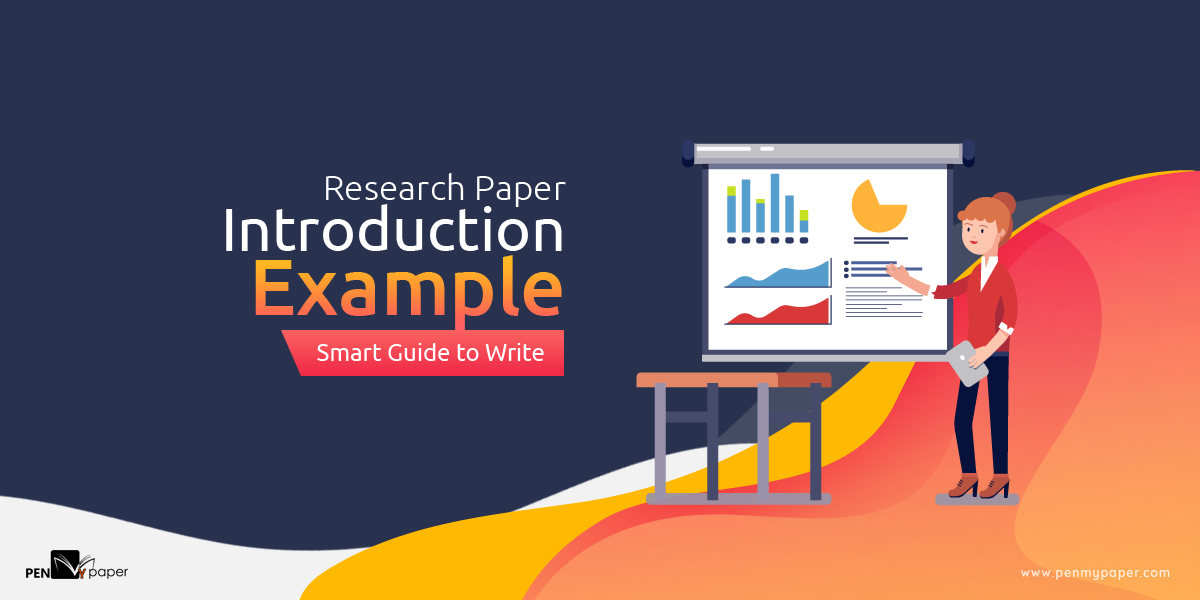
Quick Navigation
- 1. What is a Research Paper Introduction?
- 2. What are the Key Features of a Research Paper Introduction?
- 3. What to Include in the Research Paper Introduction?
- 4. Research Paper Introduction Example – A Detailed Illustration
- 5. Research Paper Introduction Examples
- 6. Things to Keep in Mind Before Writing the Research Paper Introduction
- 7. Summing Up
Research paper writing is an essential part of the academic process. Writing a research paper entails several stages, including selecting a topic, gathering information, analyzing data, and presenting findings. However, the introduction of a research paper is a crucial section as it sets the tone for the rest of the document. In this blog, we will elaborate on the key components of a research paper introduction and share some fascinating comprehensive research paper introduction examples, which will provide insight into writing an effective introduction for your research paper. In the meantime, if you feel like you need an expert to help you with your coursework, don’t hesitate to connect with our write paper service .
What is a Research Paper Introduction?
A research paper introduction is the opening section of a research paper that provides an overview of the research. It reflects more than just introducing the topic of the study. The introduction gives a comprehensive yet concise overview of the research topic and tries to establish its significance in front of the readers.
In a research paper introduction, the writer provides background information on the topic, states the research problem or question, and presents the thesis statement or main argument that will be supported in the rest of the paper. Writers may also provide a brief overview of the research methodology that will be used in the research, as well as any limitations or scope that should be considered. Overall, the goal of a research paper introduction is to provide the readers with enough information to understand the context of the research and why it is important, while also setting up the rest of the paper for success.
You might also be interested in getting a detailed understanding of how to write a research paper abstract .
What are the Key Features of a Research Paper Introduction?
A research paper introduction is a fundamental part of both the research paper and the proposal. It goes beyond providing a brief overview of the research paper topics , as it includes crucial elements such as background, aims, objectives, and research questions.
- The introduction must answer the ‘why’ questions related to the research, such as why the study is being conducted, why it is important, and why this particular topic was chosen.
- Additionally, the introduction helps to identify knowledge gaps and addresses them throughout the paper.
- To ensure effectiveness, it is important to use concise and clear language when presenting the introduction.
What to Include in the Research Paper Introduction?
According to a structured research paper outline , there are several key components that you should include in the research paper introduction to effectively set the stage for your research and engage your audience. Here are the fundamental elements to include in the introduction:
- Introduction to the Topic/ Hook
The hook is the opening sentence or phrase of your introduction that grabs the reader’s attention and draws them in. It should be interesting, relevant, and perhaps even surprising. A good hook could be a provocative question, a startling statistic, a relevant quote, or an anecdote that sets the stage for your research.
- Research Background
The research background provides context for your study by explaining the background of the subject you are researching. This could include explaining why the topic is important, what has been done on the topic in the past, and any relevant background information that the reader needs to know. The purpose of the background section is to provide context and establish the relevance of the research.
- Problem Statement
The problem statement is a specific, focused, and concise statement that outlines the research problem or questions that your study aims to address. The problem statement should make it clear what you are researching and exemplify its importance.
The research rationale explains the justification for your study and why it is important to address the research problem. This component should explain the significance and relevance of your research in the context of the larger field or industry.
The research aim is a general statement that describes the overall goal of your study. It should be broad enough to encompass the scope of your research but specific enough to provide direction for your research objectives.
- Research Objectives
The research objectives are specific, measurable, and achievable goals that you aim to accomplish through your research. They should be closely linked to your research problem and aim and should provide a clear roadmap for your research.
A research hypothesis is a statement that predicts the relationship between two or more variables in your study. It should be testable and provide a clear direction for your research. Not all research papers will have a hypothesis, but they are common in quantitative research.
- Research Questions
Research questions are specific, focused questions that you aim to answer through your research. They should be closely linked to your research problem and aim and should guide your research methodology and analysis.
- Thesis Statement
The thesis statement is the central argument or research question of your paper. It should be clear and concise and should summarize the main argument or research question that you will support with evidence and analysis in the body of your paper.
- Methodology
You may briefly outline the methodology and approach that you will use in your research. You can also provide the research limitations or scope. The methodology section should provide an idea of how you will conduct your research and what you hope to accomplish.
- Significance
Finally, you must explain the significance of your research and what it can contribute to the field. This could include implications for practice, policy, or future research. The significance section should make it clear why your research is important and what impact it could have on the field.
Overall, these components work together to provide a clear and compelling introduction to your research paper, outlining the context, purpose, and direction of your study.
Research Paper Introduction Example – A Detailed Illustration
Below we have curated a detailed research paper introduction example that covers all the components discussed above for aiding you with better comprehension.
Topic: The impact of minimum wage laws on small businesses
Introduction:
The minimum wage is a highly debated topic in politics and economics. While minimum wage laws aim to improve the standard of living for workers, they also have potential consequences for small businesses, which often have limited resources. The purpose of this research paper is to examine the impact of minimum wage laws on small businesses.
Research Background:
Minimum wage laws have been a topic of debate for decades, with proponents arguing that they improve the standard of living for workers and opponents claiming that they lead to job loss and increased prices. In recent years, several states and cities in the United States have increased their minimum wage rates, which has raised concerns about the impact on small businesses.
Research Problem:
The research problem for this study is to determine how minimum wage laws impact small businesses. Specifically, we aim to answer the question: What are the potential consequences of minimum wage laws for small businesses?
Research Rationale:
Understanding the impact of minimum wage laws on small businesses is important for several reasons. Small businesses are often the engine of economic growth, and any negative consequences of minimum wage laws could have far-reaching implications for local and national economies. Additionally, the political debate around minimum wage laws is often focused on the impact on workers, with less attention paid to the potential consequences for small businesses.
Research Aim:
This study aims to determine the impact of minimum wage laws on small businesses. Specifically, we aim to identify the potential consequences of minimum wage laws for small businesses and explore strategies that small businesses can use to mitigate these consequences.
Research Objectives:
The objectives of this study are as follows:
- To review the existing literature on the impact of minimum wage laws on small businesses.
- To analyze the potential consequences of minimum wage laws for small businesses, including changes in employment, pricing, and profitability.
- To identify strategies that small businesses can use to mitigate the potential negative consequences of minimum wage laws.
Research Hypothesis:
We hypothesize that minimum wage laws have a negative impact on small businesses, leading to job loss, increased prices, and reduced profitability. However, we also believe that small businesses can take steps to mitigate these negative consequences, such as increasing productivity and finding new revenue streams.
Research Questions:
- What is the existing literature on the impact of minimum wage laws on small businesses?
- How do minimum wage laws impact small businesses in terms of employment, pricing, and profitability?
- What strategies can small businesses use to mitigate the potential negative consequences of minimum wage laws?
Thesis Statement: “While minimum wage laws aim to improve the lives of low-wage workers, they often have unintended consequences for small businesses, including increased operating costs and reduced employment opportunities.”
Significance: The minimum wage laws are a widely debated policy issue with potential impacts on both workers and businesses. Understanding the effects of these laws on small businesses is crucial for policymakers and business owners alike, as it can inform decisions regarding minimum wage legislation and business practices.
Research Paper Introduction Examples
Below we have provided two elucidative research paper introduction examples to help understand how an introduction is typically written.
Title: Exploring the Effectiveness of Mindfulness-Based Interventions for Sustainable Weight Loss and Improved Health Outcomes in Individuals with Obesity
Obesity is a major public health concern, with nearly 40% of American adults classified as obese. In recent years, the prevalence of obesity has increased dramatically, leading to a rise in related health problems such as type 2 diabetes, cardiovascular disease, and certain types of cancer. While many factors contribute to the development of obesity, including genetics and environmental factors, dietary habits and physical activity levels are two of the most important modifiable risk factors. However, traditional weight loss interventions such as diet and exercise programs have had limited success in producing sustained weight loss. As a result, there is a need for innovative approaches to weight management that address the underlying behavioral and psychological factors that contribute to obesity. This paper aims to explore the effectiveness of mindfulness-based interventions in promoting sustainable weight loss and improving overall health outcomes in individuals with obesity. Through a comprehensive review of the existing literature and a randomized controlled trial, this study aims to contribute to the development of more effective weight management strategies that can have a significant impact on public health.
Breakdown: In this example, the hook is the statistic on the prevalence of obesity and its related health problems. The background provides context on the contributing factors to obesity and the limitations of traditional weight loss interventions. The research problem is the need for innovative approaches to weight management that address behavioral and psychological factors. The research rationale is the potential impact of these approaches on public health. The research aim is to explore the effectiveness of mindfulness-based interventions. The research objectives are to conduct a literature review and a randomized controlled trial. The research hypothesis is that mindfulness-based interventions will lead to sustained weight loss and improved health outcomes. The research questions are what is the effectiveness of mindfulness-based interventions in promoting weight loss and improving health outcomes in individuals with obesity? Lastly, the thesis statement is that this study aims to contribute to the development of more effective weight management strategies that can have a significant impact on public health.
Title: The Impact of Early Childhood Education on Academic Achievement
Education is a fundamental right for all children, and quality early childhood education (ECE) has been shown to have a significant impact on a child’s academic achievement. Research indicates that children who participate in high-quality ECE programs perform better in school, have better social skills, and are more likely to graduate from high school and attend college. However, not all children have access to high-quality ECE programs, and there is a significant achievement gap between children from low-income families and their peers. This research paper aims to explore the impact of early childhood education on academic achievement, with a focus on the factors that contribute to successful ECE programs and how to ensure that all children have access to high-quality ECE. The research problem is the achievement gap between children from low-income families and their peers, and the research objectives are to identify the characteristics of effective ECE programs, examine the impact of ECE on academic achievement, and explore policies that promote access to high-quality ECE for all children. By understanding the impact of early childhood education on academic achievement, this research can inform policies and practices that promote equity and opportunity for all children.
Note: In both examples, the introduction is written in a single paragraph, however, there is no hard and fast rule about how many paragraphs a research paper introduction should be written in. Some introductions can be effectively written in a single paragraph, while others may require more than one paragraph to adequately introduce the topic and set the stage for the research.
The most important consideration is to ensure that the introduction is clear, concise, and effectively sets up the research to follow. If that can be accomplished in a single paragraph, then that is perfectly acceptable. However, if multiple paragraphs are necessary to fully introduce the topic and research objectives, then that is also acceptable.
Ultimately, the length and structure of the introduction should be determined by the needs of the research and the expectations of the target audience.
Things to Keep in Mind
Before starting to write the introduction of a research paper, here are some things to keep in mind:
- Understand the assignment requirements: Make sure you fully understand the assignment requirements and guidelines for the research paper, including the required length, format, and citation style.
- I dentify your audience: Consider who your target audience is and what they are expecting to learn from your research paper. This will help you tailor your introduction to meet their needs.
- Conduct thorough research: Before writing the introduction, ensure that you have conducted thorough research on the topic. This will help you understand the background and context of the research and provide a strong foundation for your introduction.
- Develop a clear thesis statement: Your thesis statement is the backbone of your research paper and should be clear, concise, and specific. Develop a strong thesis statement that sets the tone for the rest of the paper.
- Create an outline: An outline can help you organize your thoughts and ideas, and ensure that your introduction flows smoothly and logically.
- Write a draft: Once you have conducted research and created an outline, write a draft of your introduction. This will help you refine your ideas and identify any areas that need further development or clarification.
- In-text citations: It’s important to keep in mind the need for accurate and consistent in-text citations while writing the introduction and throughout your paper. Make sure to properly cite any sources you use, including direct quotes, paraphrased information, and any ideas or data that you have used. This not only ensures that you give credit where it is due, but it also helps to strengthen the credibility of your research.
- Revise and edit: After writing a draft of your introduction, revise and edit it to ensure that it is clear, concise, and effective. Make sure that the language and tone are appropriate for your audience, and that all necessary information is included.
Looking for some unique and engaging commemorative speech topics ?
A well-crafted introduction is just as important as the research itself, as it can greatly contribute to the success of the paper. To achieve a strong introduction, it is crucial to be concise yet compelling, maintain clarity in research problems and objectives, and organize the content effectively. This guide aims to assist in crafting an effective research paper introduction. However, if further concerns arise, you can seek help from our essay writing help. We have a team of experienced academic writers who can assist with various assignments, so let us know if you require any assistance.

Management Paper Blog Academic Writing Guides And Tips

- Three Research Paper Introduction Examples: Learn How to Initiate and Hook
- ManagementPaper
- Apr 13, 2021
A research paper introduction holds perhaps the most importance for a study to be successful. After a good research paper abstract , it is the introduction that builds the interest in a reader to continue reading the research paper. If the introduction turns out to be dull and drab, then the study would be a failed one.
A good research paper needs a lot of background study, which you often fail to do. To make your work easier, Management Paper is there for you to help you write yours efficiently.
Key Features of a Research Paper Introduction
- It forms the basic part of both the research paper as well as the research proposal .
- Apart from giving a general notion about the research paper topic , it includes important elements such as background, aim, objectives, questions and many more.
- It must contain the questions ‘WHY’: why is the research conducted, why it is important, why this chosen topic and so on is.
- It helps in pointing out the knowledge gaps and fills them up throughout the paper.
- Use precise and clear points.
The Most Commonly Included Elements in The Research Papers
There are different kinds of research papers like essays, reports, dissertations and journals. The introduction which is generally used in case of all other types of research paper except dissertations are similar in nature. Such an introduction is similar to a summary of the topic, defining the problem, stating the aims and objectives that are going to be established through the research.
But in case of dissertation, in a good research paper format the introduction is presented in great detail by dividing the section into the following parts:
- Research background
- Research problem
- Research rationale
- Research aim
- Research objectives
- Research hypothesis
- Research questions
Apart from this, many papers include time plan, scope and limitations of the research too. The experts from the team of Management Paper can help you with your paper writing and also make you understand the various aspects of a research paper.
Some Significant Examples of Research Paper Introduction
Research paper introduction example #1, topic: impact of leadership effectiveness on employees for the company amazon (dissertation).
| The leadership quality of the leaders of a company has a direct impact on the work behaviour of the employees that includes creativity, self-efficacy, coping up with stress and motivation of the various employees.The company, Amazon, follows a transformational leadership which involves the powerful vision of a leader or the CEO, like Jeff Bezos, that has resulted in unimaginable success of the company. |
The history and the various past events related to the topic are being mentioned in this section. Thsi supplies context to the paper and contains both relevant and important studies. Authenticating your information is a must by in-text citations.
| The criticism was seriously considered by the company and they have ensured workplace support and safety for the employees. They implemented almost 150 process changes, set up testing stations which would regularly sanitise the workplace and increased the pay of the employees (Yohn, 2020). In the year 2019, the company’s total global headcount exceeded 3/4th of 100000 people which was a benchmark for recruiting the employees in the US. With a total number of employees of 750,000, the 3rd quarter was finished by Amazon, a 22% jump than the previous year and the count rose to 400,000 (Levy, 2019). |
The research problem states a specific area of concern, a bothering question, a difficulty which is to be eliminated or a condition that demands improvement. The missing knowledge about the topic is being found out through this and then only you can do further research about the problem.
| Amazon started in the year 1994 as just a book seller and then expanded the various sectors in the company and grew into a huge company with a net revenue of $178 billion in 2017 (Statista, 2020). The company is still expanding with the most recent acquisition with Ring. But this leadership of Amazon has made the company run through major losses through failed acquisitions, failed projects and lost the key employees consequently. Recently Jeff Bezos and Amazon have faced criticism towards their ill-treatment of the employees. It was reported that employees were working in unsafe and unsatisfactory working conditions at the warehouses. |
The rationale answers the question of why the research is being conducted and thus states its importance.
| The aim of this research is to analyse the impact of the leadership on the employees of Amazon and explore how effective were the measures taken by the leaders to enhance the employee experience. The negative effects of leadership on the employees will also be analysed in this paper. |
The things that are expected to be achieved at the end of the research are generally mentioned here.
| To analyse the role of a leader in employee satisfactionTo understand the impact of leadership qualities on the employees of AmazonTo observe whether the qualities of the leader of the company exert unwanted pressure on the employees that resulted in bad working conditions for the employees. |
The objectives are the various goals or targets that are to be established and achieved throughout the study.
| What is the reaction of the employees of Amazon towards the leadership qualities of its leader?What is the role of a leader in motivating the employees of Amazon?What are the different steps adopted by the leaders to inspire the employees and create a good employee base? |
The research question points out the facts that are to be established through the paper and provides the research with a clear focus and purpose.
| Hypothesis1 (H1): The leader of Amazon has become quite an inspiration for the employees of the company and has been motivating the employees based on the leader’s management practices and philosophies. Hypothesis 2 (H0): At times, the motivating words of the leader of the Company, Amazon, becomes burdensome for the employees and the leader seems to take the employees for granted that resulted in intolerable working conditions of the employees and extreme disappointment on their part. |
This is a specific predictive statement about the possible future outcome of the study which is mostly based upon the relationship between different variables or on a single variable.
Research Paper Introduction Example # 2
Topic: implementing online customer support service through chat portal at aldi.
| The given examination will highlight on the ground that brings down an emphasis on how a successful business experience took care of the progression engaged in innovative advancement concerning the procedure that was to be realized for developing online chat portal as it would be developed at Aldi. The alterations in the development ground allowed critical associations to change according to them. The use of web based systems administration has overhauled the limit in the notice of their association. The introduction of digitalization has bounced out at various organizations as an opportunity to interface with their customers in developing a proper underpinning that articulately presents financial statements and the feedback received from the stakeholders and the customers. |
Research Paper Introduction Example # 3
Topic: compare and contrast the policies for the aged people in various countries.
| Around 7 billion people are currently living on this blue planet. Developments in technology and medicine have led to higher life expectancy rates. This, in turn, has led countries to formulate different plans and policies for the elderly. These policies are formulated based on several parameters. This is so because different countries have different life expectancy rates and problems concerning aged people. In this report, apart from New Zealand, the three other countries, which will be focused on, are Australia, Canada and India. With several pension plans, health policies and government programs, Canada tries to make sure that the elderly are treated well. Policies in Australia and New Zealand are almost similar, both promoting healthcare and pension plans for the aged. These policies also promote better healthcare distribution, especially in rural areas. India, on the other hand, has a population of more than a billion and is not a first world country. A comparison between these policies and its impact on the economy and society could be beneficial to assess the plans and flaws and understand the areas which might require improvements. New Zealand, Australia and Canada have developed countries while India is different from these countries, in the sense, that its population is massive and it is not as developed as the other three. Therefore, a comparison between the policies in these countries may lead to new ideas. |
In both the second and the third example, the introduction is written in a single paragraph. In the first line itself you must introduce the topic. Try to avoid embellishments. Write any remarkable event about the topic then. Explain the problem and the purpose of the research. Try to build a reasonable thesis statement. Then with few lines, insert a smooth transition to make a shift from the introduction to the body.
You can check out more examples from the page of Management paper, and can also avail paper writing service from them with ease. We do not compromise with quality and believe in time management.
Save Times & Improve Grades
Just share your ruquirements and get customized solutions on time

Popular Posts

- Research Paper Format: Know How to Structure Your Paper

- Research Proposal Outline: Learn to Propose the Plan Properly
- 50 Great Debatable Topics to Make Your Essay A Brilliant One

- Step by Step Guide to Draft A Research Paper Outline

- Comparing and Contrasting Through Compare and Contrast Essay Examples
- The Types of Essays: Four Popular Genres

- The Easiest Way to Draft A Formal Essay
- Learn the Basic Essay Format Through Some Easy Steps
- The Various Angles of Essays Through Cause-and-Effect Essay Examples

Research Paper Introduction
Ai generator.
The introduction of a research paper is a critical component that sets the tone for the entire study. It serves as the gateway for readers to delve into the research topic, understand its significance, and grasp the context of the study. A well-crafted introduction captures the attention of readers, provides a clear overview of the research, and sets the stage for the subsequent sections. In this article, we will explore what makes an effective research paper introduction, provide a step-by-step guide on how to write one, address frequently asked questions, and conclude with a touch of creativity.
1. Research Paper Template
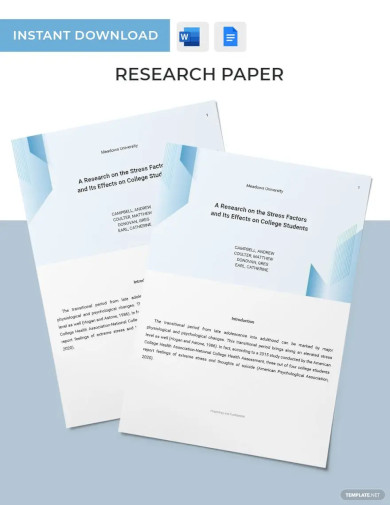
- Google Docs
- Apple Pages
2. Research Paper Format
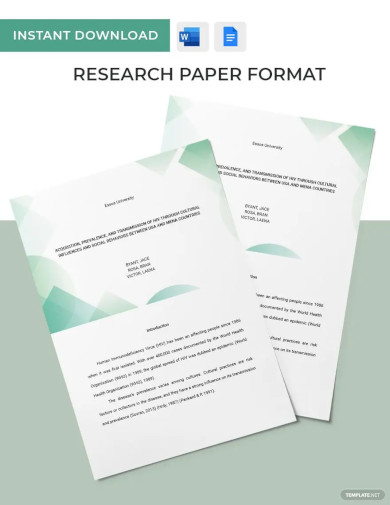
3. Research Paper Outline Template
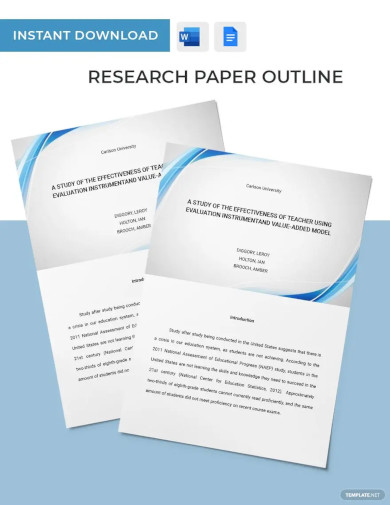
4. Research Paper Review Template
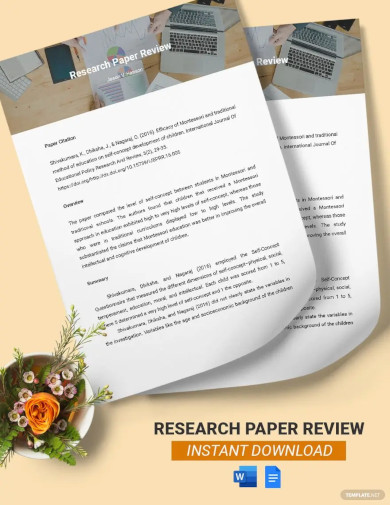
5. Writing Research Paper Introductions
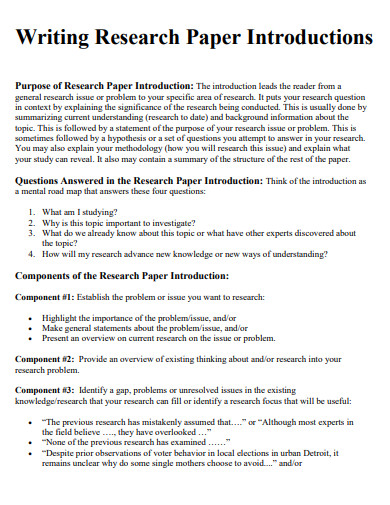
Size: 84 KB
6. Research Paper Introduction Paragraph
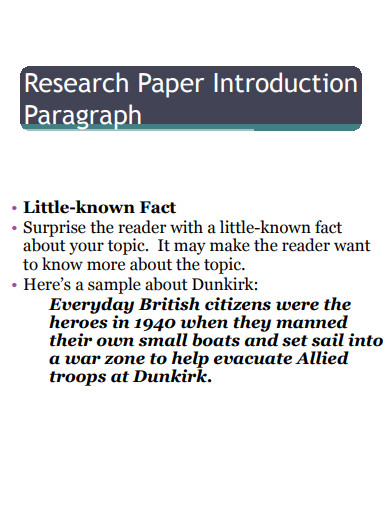
Size: 126 KB
7. Research Paper Introduction Example
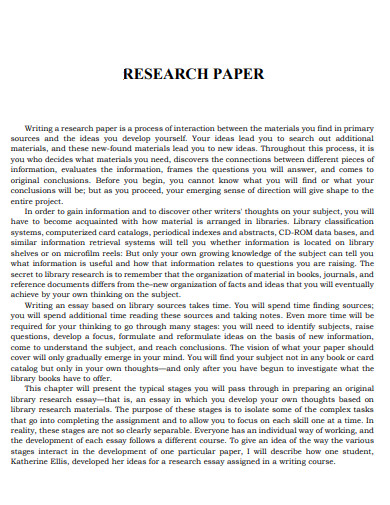
Size: 842 KB
8. Linear Equations Research Paper Introduction
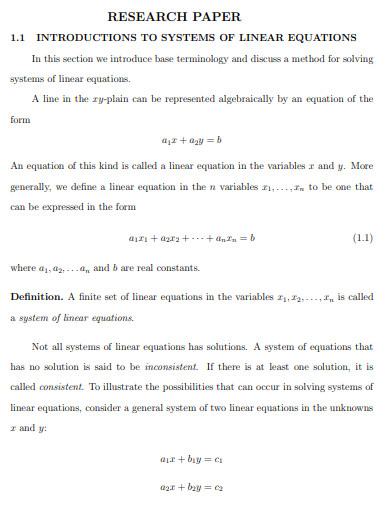
9. Organization Research Paper Introduction
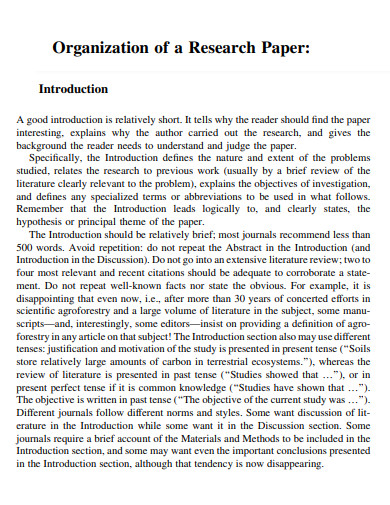
Size: 161 KB
10. Argument Research Paper Introduction
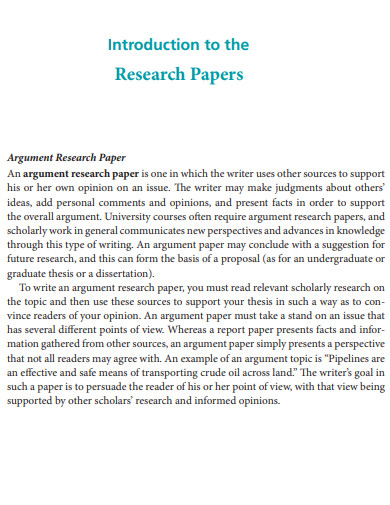
11. Introduction Section for Research Papers
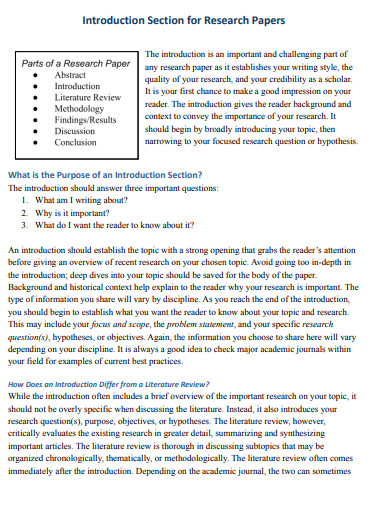
12. Sample Introduction Research Papers
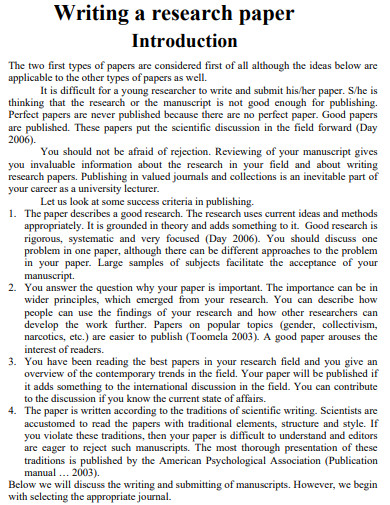
Size: 54 KB
13. Simple Introduction Research Papers
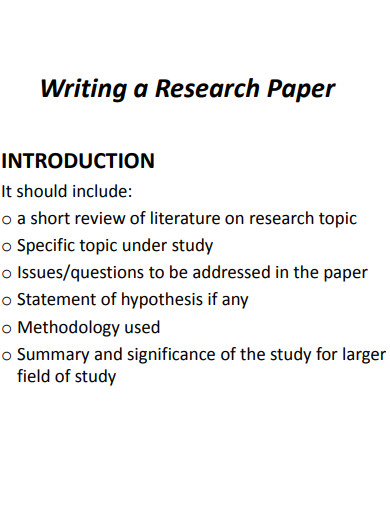
Size: 668 KB
14. Introduction Scientific Research Papers
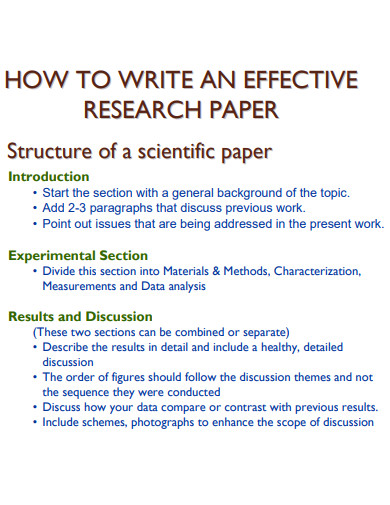
Size: 417 KB
15. Basic Research Papers Introduction
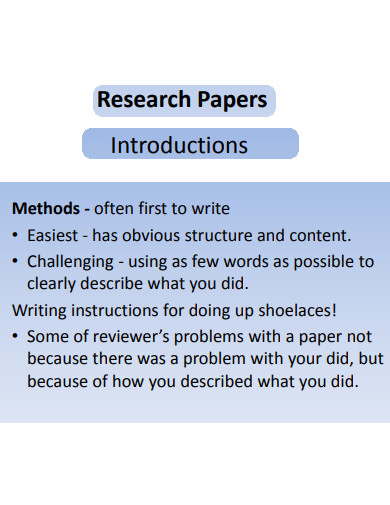
16. Economics Research Papers Introduction
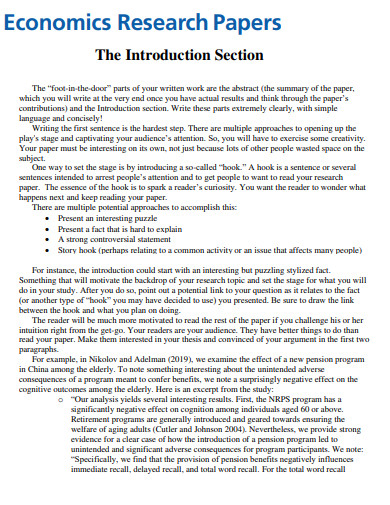
Size: 283 KB
17. Research Paper Proposal Introduction
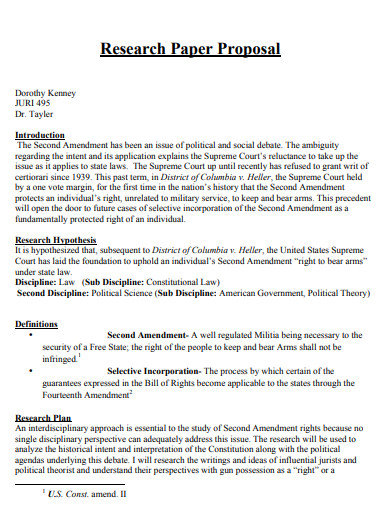
Size: 184 KB
18. Literature Review Research Paper Introduction
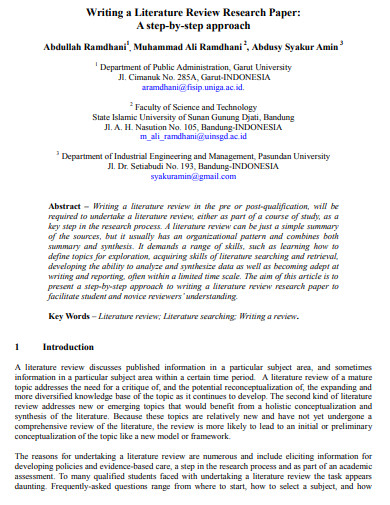
Size: 363 KB
19. General Research Paper Introduction

20. Standard Research Paper Introduction
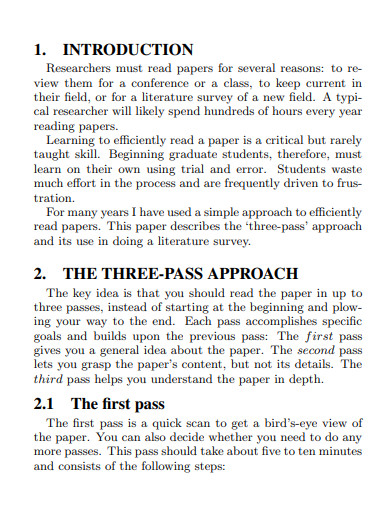
21. Steps for Research Paper Introduction
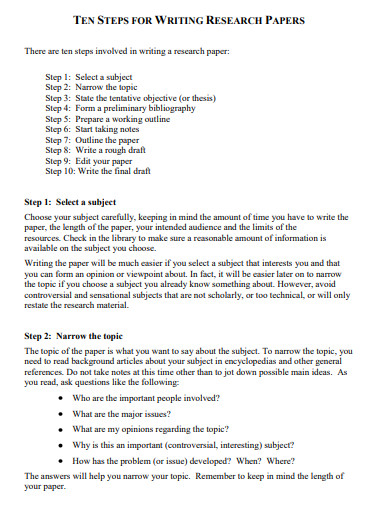
Size: 108 KB
22. Good Research Paper Introduction
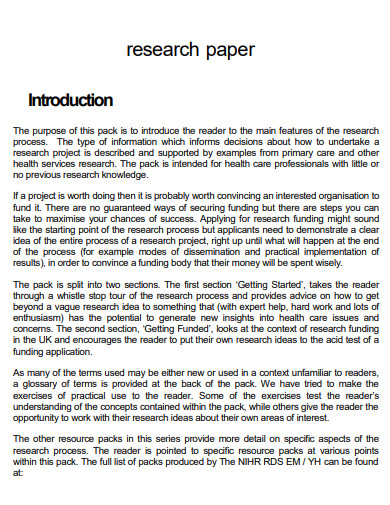
Size: 160 KB
23. Research Paper Introduction Outline

Size: 24 KB
24. Printable Research Paper Introduction
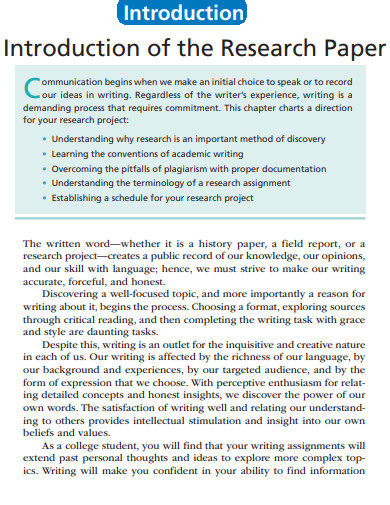
Size: 11 MB
25. Formatting Research Paper Introduction
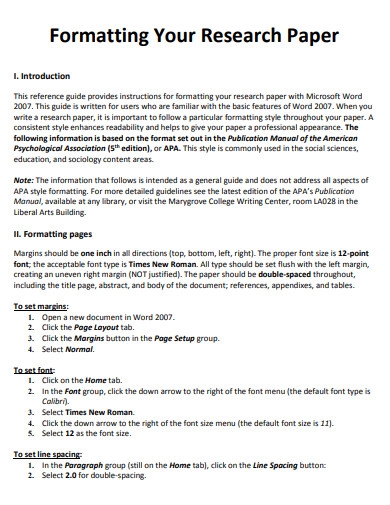
Size: 223 KB
26. Editable Research Paper Introduction
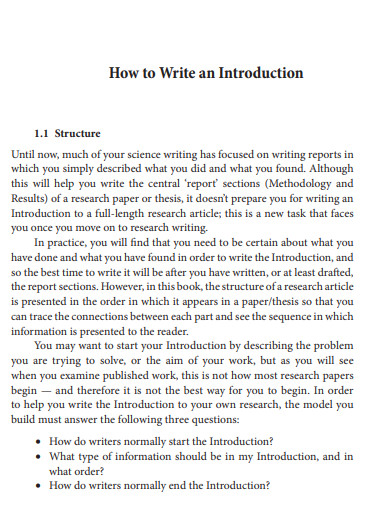
Size: 255 KB
27. Research Paper Introduction Layout
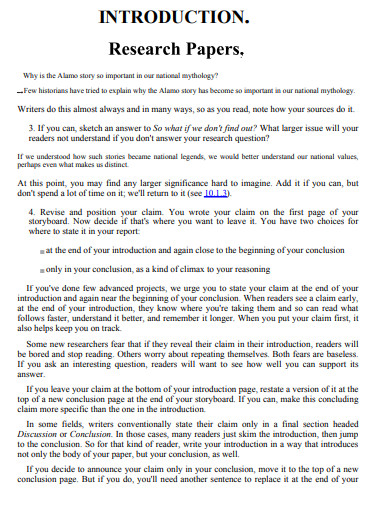
What is an Effective Research Paper Introduction
An effective research paper introduction is a concise and engaging opening section that entices readers to continue reading. It presents the research topic, outlines the objectives and purpose of the study, and highlights the relevance and significance of the research. A well-written introduction provides a clear and logical flow of information, guiding readers through the research problem, and establishing the groundwork for the subsequent sections of the paper.
How to Write an Effective Research Paper Introduction
Crafting an effective research paper introduction is crucial for capturing readers’ attention and setting the stage for your study. This guide will provide you with a step-by-step approach to master the art of writing an engaging and informative introduction. By following these guidelines, you can create a compelling opening that establishes the context, outlines objectives, and conveys the significance of your research.
Step 1: Understand the Research Paper Format:
Before diving into the introduction, familiarize yourself with the required research paper format . Depending on the discipline, you may need to follow specific guidelines such as APA format , MLA paper format , or others. Understanding the text structure and citation requirements is crucial for creating a cohesive and well-structured introduction.
Step 2: Define the Research Design:
In the introduction, briefly describe the research design employed in the study. Explain whether it is a qualitative, quantitative, or mixed methods approach. This information will help readers understand the type of data collection and analysis methods used to address the research problem.
Step 3: Craft a Research Outline:
Develop a research outline that acts as a roadmap for your study. This outline will help you organize your thoughts and ensure a logical flow of information in the introduction. Include the main sections and subsections that will be discussed in the paper, giving readers a preview of the paper’s structure.
What is the difference between APA and MLA format?
APA and MLA are two commonly used formatting styles for research papers. APA (American Psychological Association) format is typically used in the social sciences, while MLA (Modern Language Association) format is more common in the humanities. Both styles have specific guidelines for formatting citations, references, margins, fonts, and other elements. Check out our article on “ 14+ APA vs MLA Format Examples in PDF ” for more detailed comparisons.
Can you provide examples of research summary papers?
Certainly! We have a collection of research summary examples that can serve as a guide for summarizing research papers effectively. These examples demonstrate the essential components of a research summary and showcase different writing styles and approaches.
Where can I find research outline examples?
If you’re looking for research outline examples , we have a comprehensive article that provides a variety of sample outlines across different disciplines. These examples will help you structure your research paper effectively, ensuring a logical flow of ideas and information.
Writing an effective research paper introduction requires careful planning, clarity of thought, and attention to detail. By following the step-by-step guide provided here, you can create an engaging introduction that captivates readers and sets the stage for your research. Remember to adhere to the prescribed research paper format, such as APA or MLA, and utilize appropriate citations to support your claims. With a compelling introduction , your research paper will not only pique readers’ interest but also lay a solid foundation for the rest of your study.
Text prompt
- Instructive
- Professional
10 Examples of Public speaking
20 Examples of Gas lighting
Have a language expert improve your writing
Run a free plagiarism check in 10 minutes, generate accurate citations for free.
- Knowledge Base
- Dissertation
How to Write a Thesis or Dissertation Introduction
Published on September 7, 2022 by Tegan George and Shona McCombes. Revised on November 21, 2023.
The introduction is the first section of your thesis or dissertation , appearing right after the table of contents . Your introduction draws your reader in, setting the stage for your research with a clear focus, purpose, and direction on a relevant topic .
Your introduction should include:
- Your topic, in context: what does your reader need to know to understand your thesis dissertation?
- Your focus and scope: what specific aspect of the topic will you address?
- The relevance of your research: how does your work fit into existing studies on your topic?
- Your questions and objectives: what does your research aim to find out, and how?
- An overview of your structure: what does each section contribute to the overall aim?
Instantly correct all language mistakes in your text
Upload your document to correct all your mistakes in minutes

Table of contents
How to start your introduction, topic and context, focus and scope, relevance and importance, questions and objectives, overview of the structure, thesis introduction example, introduction checklist, other interesting articles, frequently asked questions about introductions.
Although your introduction kicks off your dissertation, it doesn’t have to be the first thing you write — in fact, it’s often one of the very last parts to be completed (just before your abstract ).
It’s a good idea to write a rough draft of your introduction as you begin your research, to help guide you. If you wrote a research proposal , consider using this as a template, as it contains many of the same elements. However, be sure to revise your introduction throughout the writing process, making sure it matches the content of your ensuing sections.
Prevent plagiarism. Run a free check.
Begin by introducing your dissertation topic and giving any necessary background information. It’s important to contextualize your research and generate interest. Aim to show why your topic is timely or important. You may want to mention a relevant news item, academic debate, or practical problem.
After a brief introduction to your general area of interest, narrow your focus and define the scope of your research.
You can narrow this down in many ways, such as by:
- Geographical area
- Time period
- Demographics or communities
- Themes or aspects of the topic
It’s essential to share your motivation for doing this research, as well as how it relates to existing work on your topic. Further, you should also mention what new insights you expect it will contribute.
Start by giving a brief overview of the current state of research. You should definitely cite the most relevant literature, but remember that you will conduct a more in-depth survey of relevant sources in the literature review section, so there’s no need to go too in-depth in the introduction.
Depending on your field, the importance of your research might focus on its practical application (e.g., in policy or management) or on advancing scholarly understanding of the topic (e.g., by developing theories or adding new empirical data). In many cases, it will do both.
Ultimately, your introduction should explain how your thesis or dissertation:
- Helps solve a practical or theoretical problem
- Addresses a gap in the literature
- Builds on existing research
- Proposes a new understanding of your topic
Here's why students love Scribbr's proofreading services
Discover proofreading & editing
Perhaps the most important part of your introduction is your questions and objectives, as it sets up the expectations for the rest of your thesis or dissertation. How you formulate your research questions and research objectives will depend on your discipline, topic, and focus, but you should always clearly state the central aim of your research.
If your research aims to test hypotheses , you can formulate them here. Your introduction is also a good place for a conceptual framework that suggests relationships between variables .
- Conduct surveys to collect data on students’ levels of knowledge, understanding, and positive/negative perceptions of government policy.
- Determine whether attitudes to climate policy are associated with variables such as age, gender, region, and social class.
- Conduct interviews to gain qualitative insights into students’ perspectives and actions in relation to climate policy.
To help guide your reader, end your introduction with an outline of the structure of the thesis or dissertation to follow. Share a brief summary of each chapter, clearly showing how each contributes to your central aims. However, be careful to keep this overview concise: 1-2 sentences should be enough.
I. Introduction
Human language consists of a set of vowels and consonants which are combined to form words. During the speech production process, thoughts are converted into spoken utterances to convey a message. The appropriate words and their meanings are selected in the mental lexicon (Dell & Burger, 1997). This pre-verbal message is then grammatically coded, during which a syntactic representation of the utterance is built.
Speech, language, and voice disorders affect the vocal cords, nerves, muscles, and brain structures, which result in a distorted language reception or speech production (Sataloff & Hawkshaw, 2014). The symptoms vary from adding superfluous words and taking pauses to hoarseness of the voice, depending on the type of disorder (Dodd, 2005). However, distortions of the speech may also occur as a result of a disease that seems unrelated to speech, such as multiple sclerosis or chronic obstructive pulmonary disease.
This study aims to determine which acoustic parameters are suitable for the automatic detection of exacerbations in patients suffering from chronic obstructive pulmonary disease (COPD) by investigating which aspects of speech differ between COPD patients and healthy speakers and which aspects differ between COPD patients in exacerbation and stable COPD patients.
Checklist: Introduction
I have introduced my research topic in an engaging way.
I have provided necessary context to help the reader understand my topic.
I have clearly specified the focus of my research.
I have shown the relevance and importance of the dissertation topic .
I have clearly stated the problem or question that my research addresses.
I have outlined the specific objectives of the research .
I have provided an overview of the dissertation’s structure .
You've written a strong introduction for your thesis or dissertation. Use the other checklists to continue improving your dissertation.
If you want to know more about AI for academic writing, AI tools, or research bias, make sure to check out some of our other articles with explanations and examples or go directly to our tools!
Research bias
- Survivorship bias
- Self-serving bias
- Availability heuristic
- Halo effect
- Hindsight bias
- Deep learning
- Generative AI
- Machine learning
- Reinforcement learning
- Supervised vs. unsupervised learning
(AI) Tools
- Grammar Checker
- Paraphrasing Tool
- Text Summarizer
- AI Detector
- Plagiarism Checker
- Citation Generator
The introduction of a research paper includes several key elements:
- A hook to catch the reader’s interest
- Relevant background on the topic
- Details of your research problem
and your problem statement
- A thesis statement or research question
- Sometimes an overview of the paper
Don’t feel that you have to write the introduction first. The introduction is often one of the last parts of the research paper you’ll write, along with the conclusion.
This is because it can be easier to introduce your paper once you’ve already written the body ; you may not have the clearest idea of your arguments until you’ve written them, and things can change during the writing process .
Research objectives describe what you intend your research project to accomplish.
They summarize the approach and purpose of the project and help to focus your research.
Your objectives should appear in the introduction of your research paper , at the end of your problem statement .
Scope of research is determined at the beginning of your research process , prior to the data collection stage. Sometimes called “scope of study,” your scope delineates what will and will not be covered in your project. It helps you focus your work and your time, ensuring that you’ll be able to achieve your goals and outcomes.
Defining a scope can be very useful in any research project, from a research proposal to a thesis or dissertation . A scope is needed for all types of research: quantitative , qualitative , and mixed methods .
To define your scope of research, consider the following:
- Budget constraints or any specifics of grant funding
- Your proposed timeline and duration
- Specifics about your population of study, your proposed sample size , and the research methodology you’ll pursue
- Any inclusion and exclusion criteria
- Any anticipated control , extraneous , or confounding variables that could bias your research if not accounted for properly.
Cite this Scribbr article
If you want to cite this source, you can copy and paste the citation or click the “Cite this Scribbr article” button to automatically add the citation to our free Citation Generator.
George, T. & McCombes, S. (2023, November 21). How to Write a Thesis or Dissertation Introduction. Scribbr. Retrieved July 10, 2024, from https://www.scribbr.com/dissertation/introduction-structure/
Is this article helpful?
Tegan George
Other students also liked, how to choose a dissertation topic | 8 steps to follow, how to write an abstract | steps & examples, "i thought ai proofreading was useless but..".
I've been using Scribbr for years now and I know it's a service that won't disappoint. It does a good job spotting mistakes”

COMMENTS
The introduction to a research paper presents your topic, provides background, and details your research problem.
The introduction of a research paper provides an overview of the study's purpose, scope, and significance. Read this article to understand what is a research paper introduction, its importance and how to write a research paper introduction with examples.
Research paper introduction is the first section of a research paper that provides an overview of the study, its purpose, and the research question (s) or hypothesis (es) being investigated. It typically includes background information about the topic, a review of previous research in the field, and a statement of the research objectives.
TL; DR An introduction is a paragraph that provides information about your entire paper and aims to attract and inform the reader. Before writing an introduction or even starting your paper, you need to research academic sources. The first one or two sentences of an introduction paragraph should be a hook to attract the reader's attention.
A research paper is a piece of academic writing that provides analysis, interpretation, and argument based on in-depth independent research.
In this blog, we'll discuss how to write an introduction for a research paper and the crucial elements of a strong introduction.
Learn to craft a compelling introduction for your research paper with our expert tips. Discover how to engage readers and set the stage for your study.
How to Write an Introduction for a Research Paper How to write an introduction for a research paper? Eventually (and with practice) all writers will develop their own strategy for writing the perfect introduction for a research paper. Once you are comfortable with writing, you will probably find your own, but coming up with a good strategy can be tough for beginning writers.
This article will guide you through the process of writing an effective introduction for a research paper that grabs the reader's attention and captures the essence of your research paper.
In essence, the introduction offers the story of how and why the research project came to be. Typical structure of an introduction to an empirical research paper: Empirical research paper introductions are a type of literature review—and like all literature reviews, they follow a broad-to-narrow structure.
Research Paper Introduction Examples Looking for research paper introduction examples? Quotes, anecdotes, questions, examples, and broad statements—all of them can be used successfully to write an introduction for a research paper. It's instructive to see them in action, in the hands of skilled academic writers.
Research papers are similar to academic essays, but they are usually longer and more detailed assignments, designed to assess not only your writing skills but also your skills in scholarly research. Writing a research paper requires you to demonstrate a strong knowledge of your topic, engage with a variety of sources, and make an original contribution to the debate.
What is the purpose of an introduction? The purpose of a research paper intro is to provide an overview and context for the study being conducted. A research paper engages the reader, establishes the importance of the research topic, and outlines the study's objectives and scope.
The pages in this section cover the following topic areas related to the process of writing a research paper: Genre - This section will provide an overview for understanding the difference between an analytical and argumentative research paper. Choosing a Topic - This section will guide the student through the process of choosing topics ...
Discussion of how to understand and write different sections of a scientific paper. Discussions of how to write Abstract, Introduction, Methods, Data, and Discussion.
Having a hard time learning how to write a research paper introduction? Follow these four steps: Draw readers in. Zoom in on your topic and its
Learn how to craft compelling research paper introductions with our expert guide. Set the tone for your paper and engage your readers from the start
A good introduction paragraph is an essential part of any academic essay. It sets up your argument and tells the reader what to expect.
Learn how to write an abstract in research with this comprehensive guide. Get to know how to present the background, objectives, methods, results, and conclusions of your study to provide a concise and informative summary, with examples.
Write Your Research Paper with the Comfort of Using WPS Office. Writing a research paper involves managing numerous complicated tasks, such as ensuring the correct formatting, not missing any crucial information, and having all your data ready. The process of how to write a research paper is inherently challenging.
This article provides some great research paper introduction examples and provides insight into the key features and components to help with research paper writing.
A research paper introduction example will help you the various approaches that are to be taken for different kinds of research papers.
A research paper outline makes writing your paper more efficient. It organizes your thoughts and helps shape the flow of information.
Learn how to write an effective research paper introduction that captivates readers and sets the stage for your study. This step-by-step guide provides essential tips for crafting an engaging opening, outlining objectives, and conveying the significance of your research. Master the art of introductions and create compelling research papers.
This example serves as an introduction to RL concepts and classical Q-learning methods, which align with a cognitivism teaching approach. ... as discussed in the Introduction, the use of research and industrial robots presents technical challenges, including high costs, limited access, and operational complexity. ... the paper provides a ...
The introduction is the first section of your thesis or dissertation, appearing right after the table of contents. Your introduction draws your reader in, setting the stage for your research with a clear focus, purpose, and direction on a relevant topic.